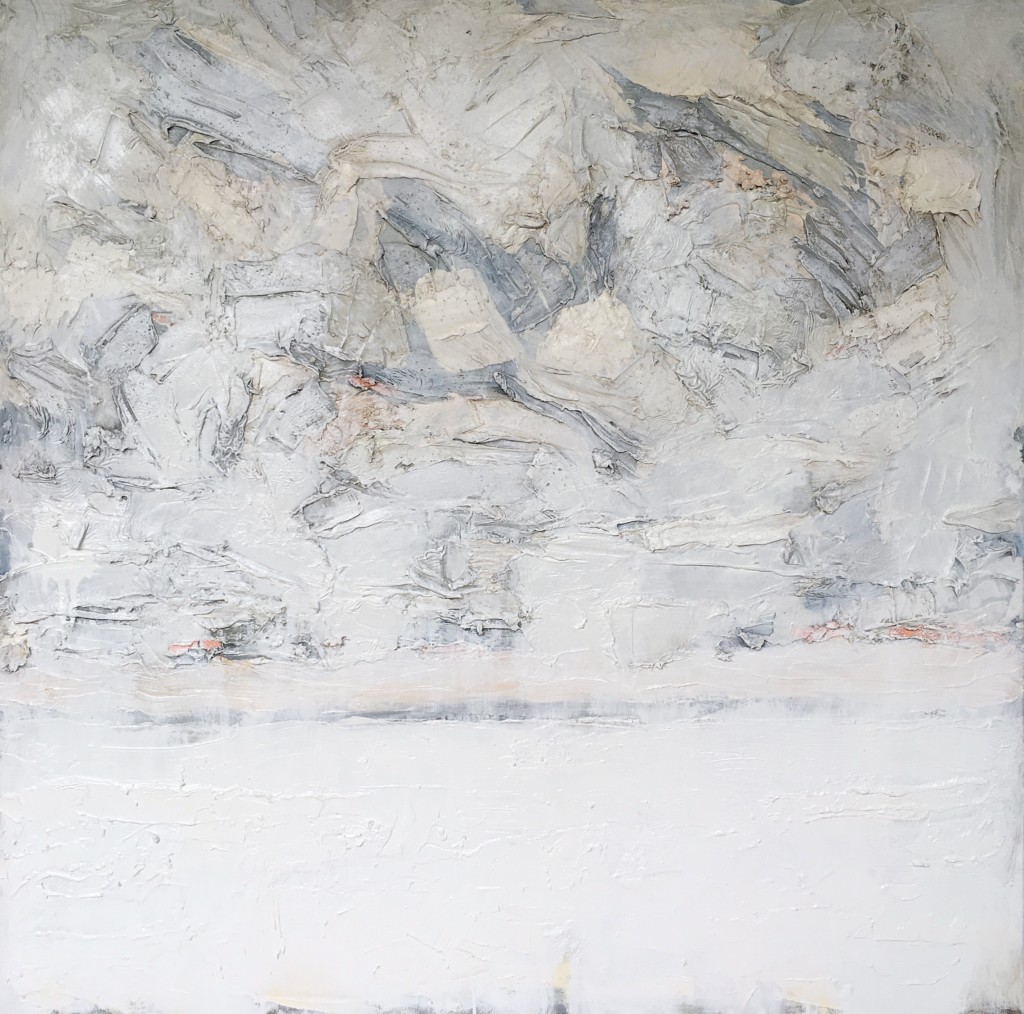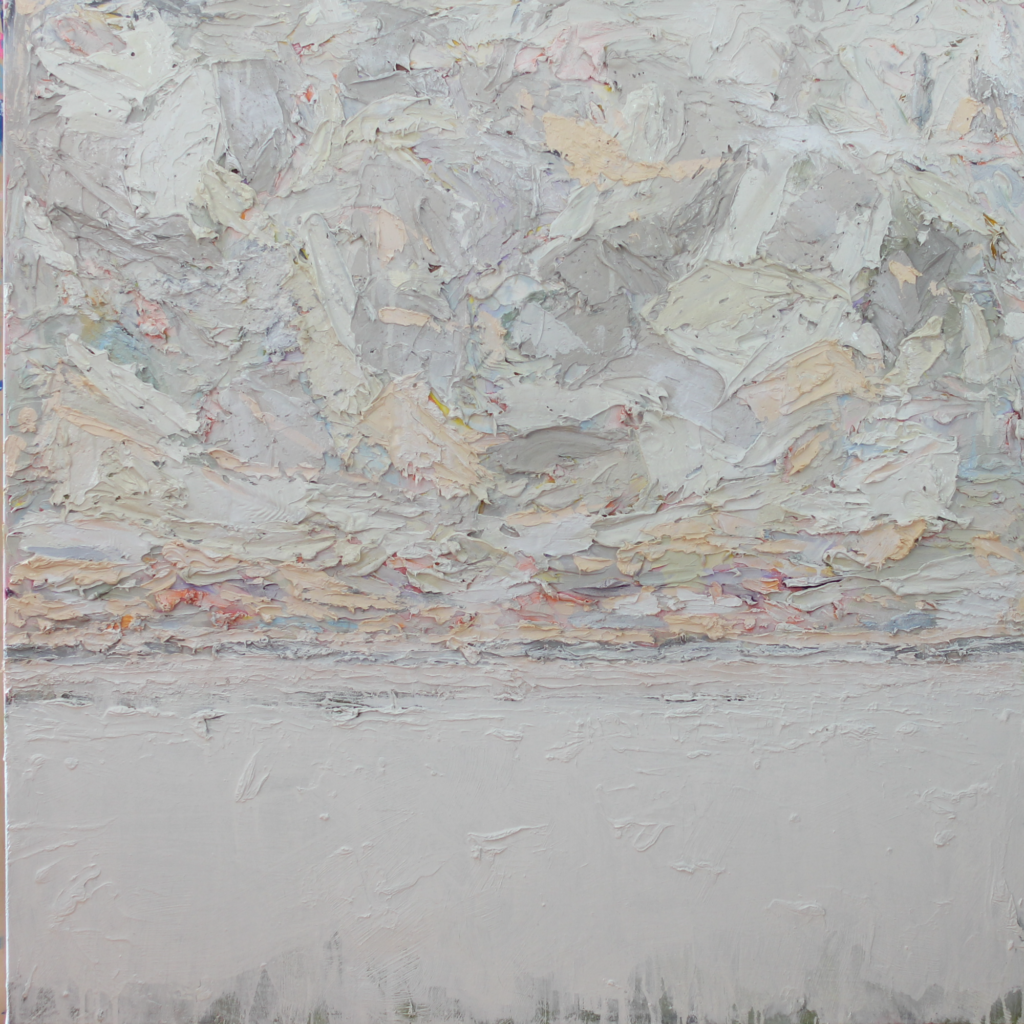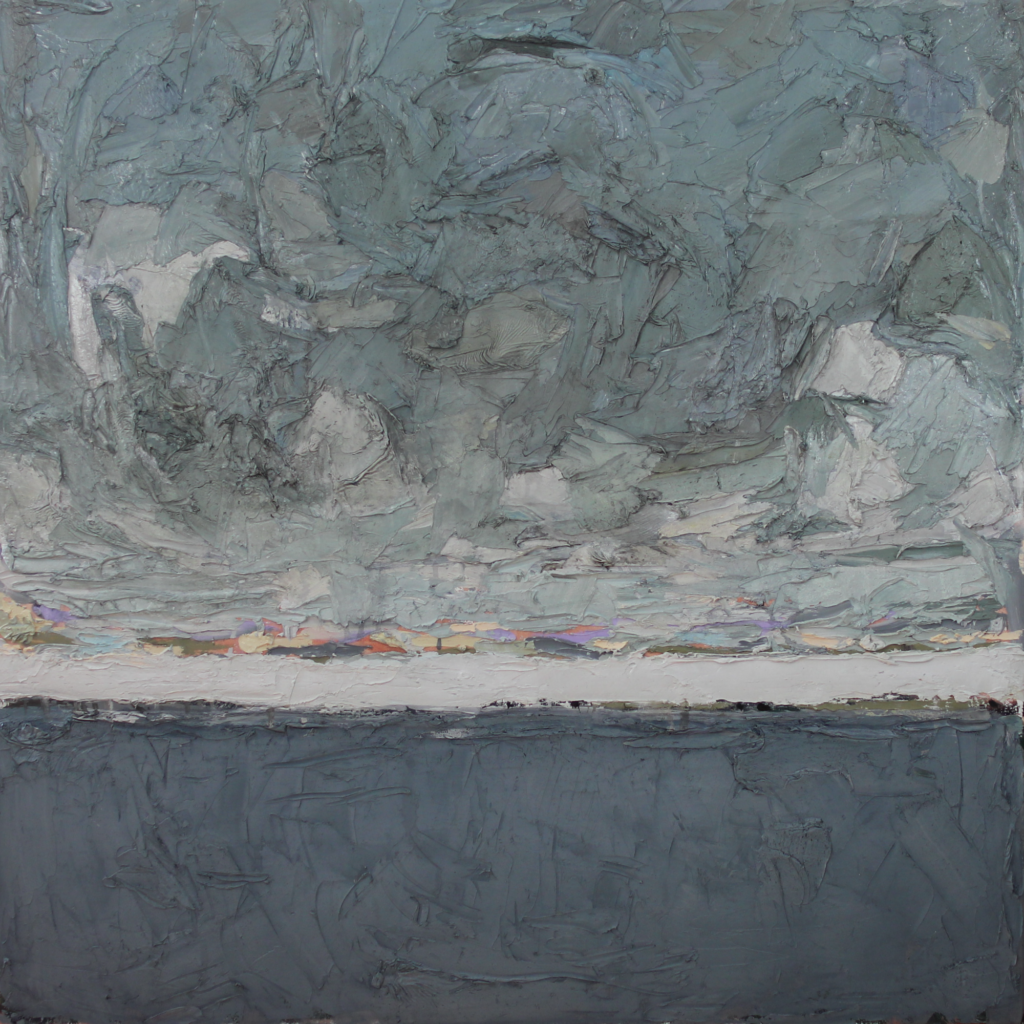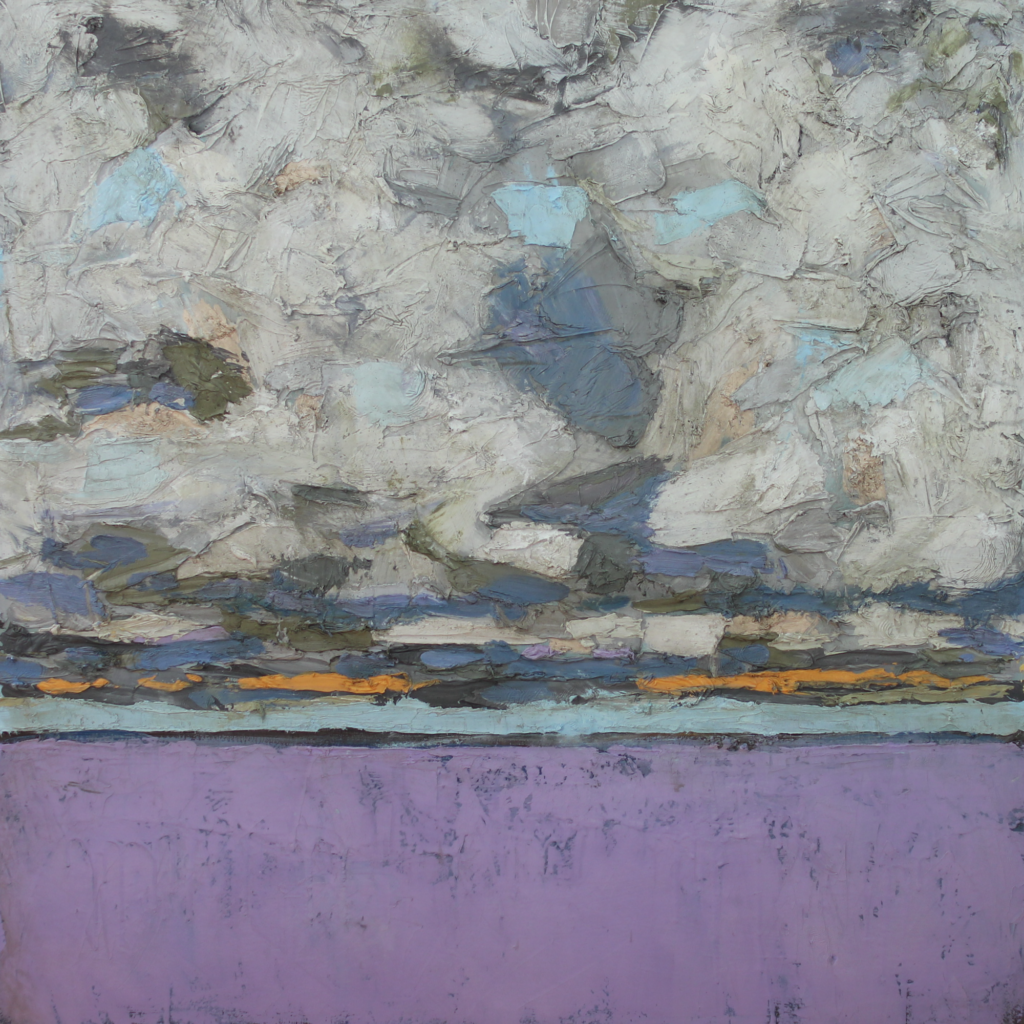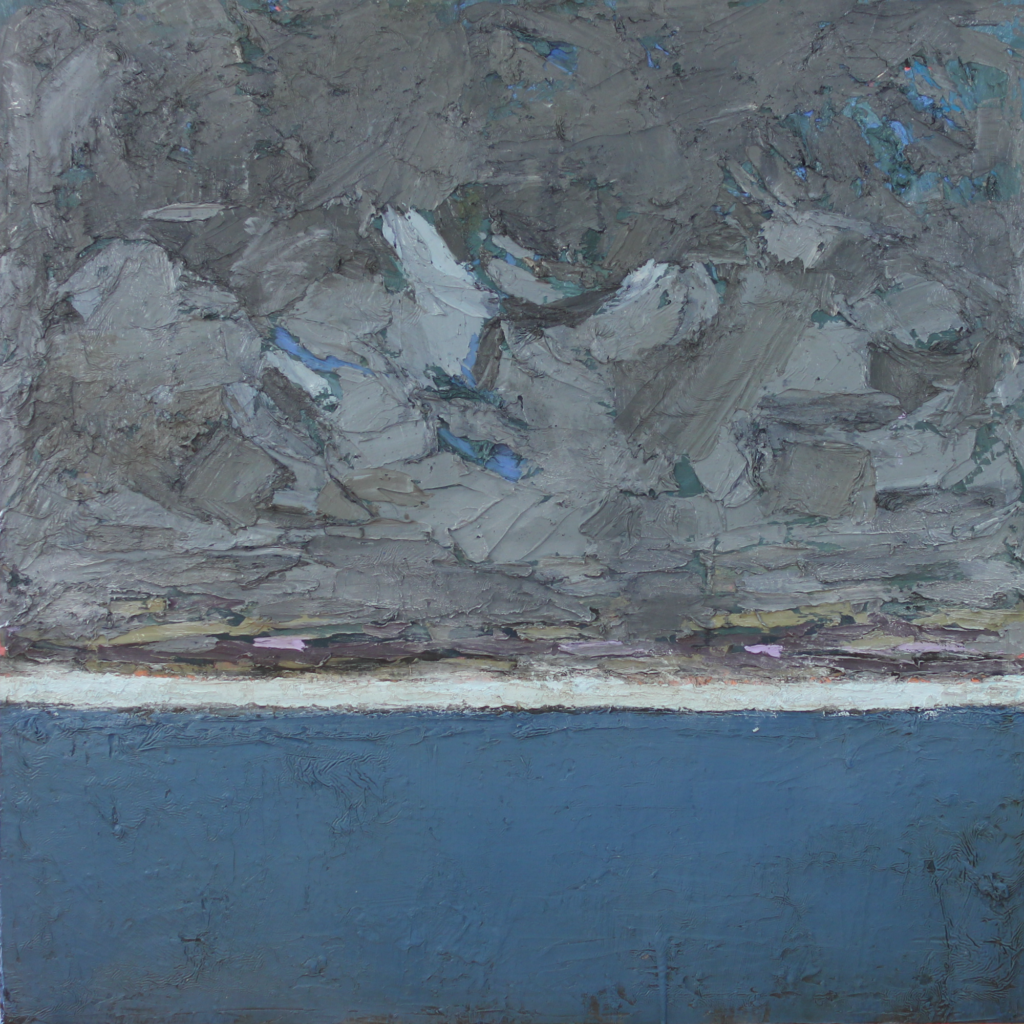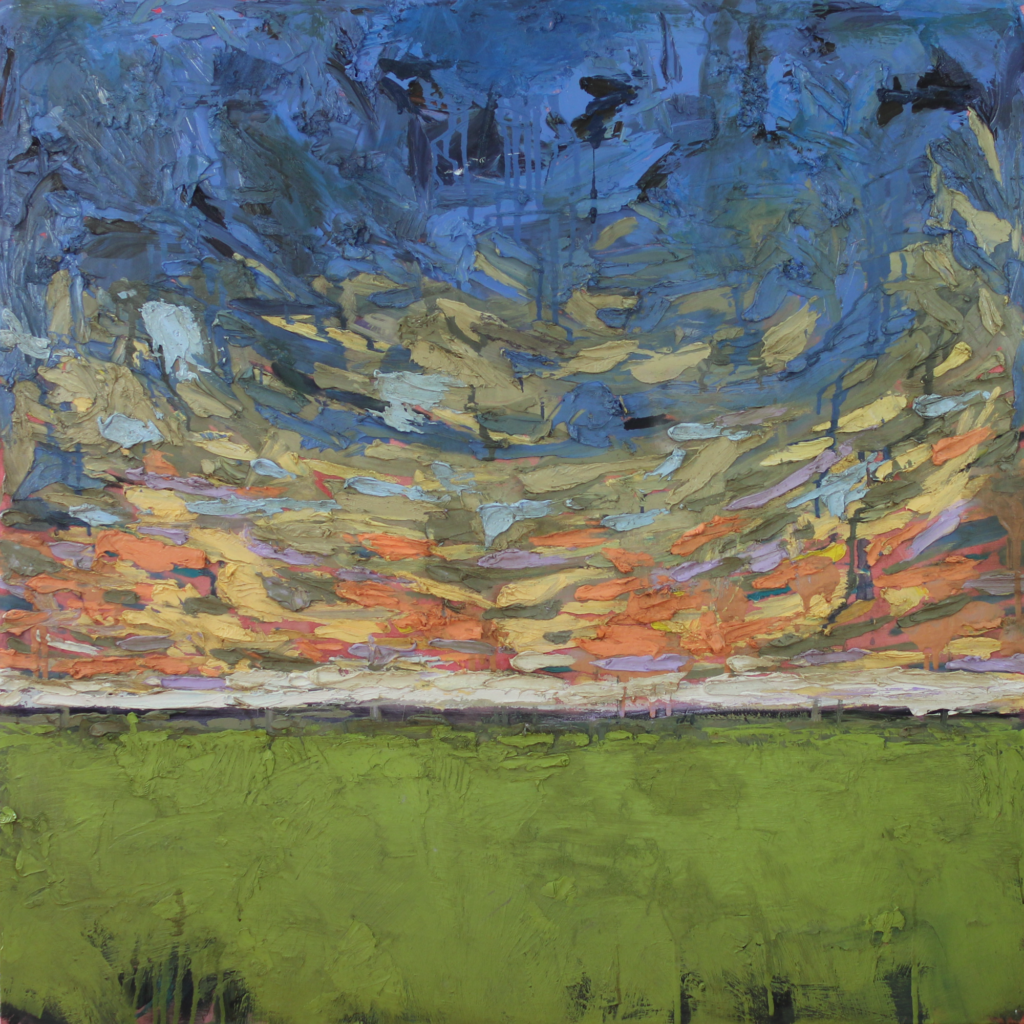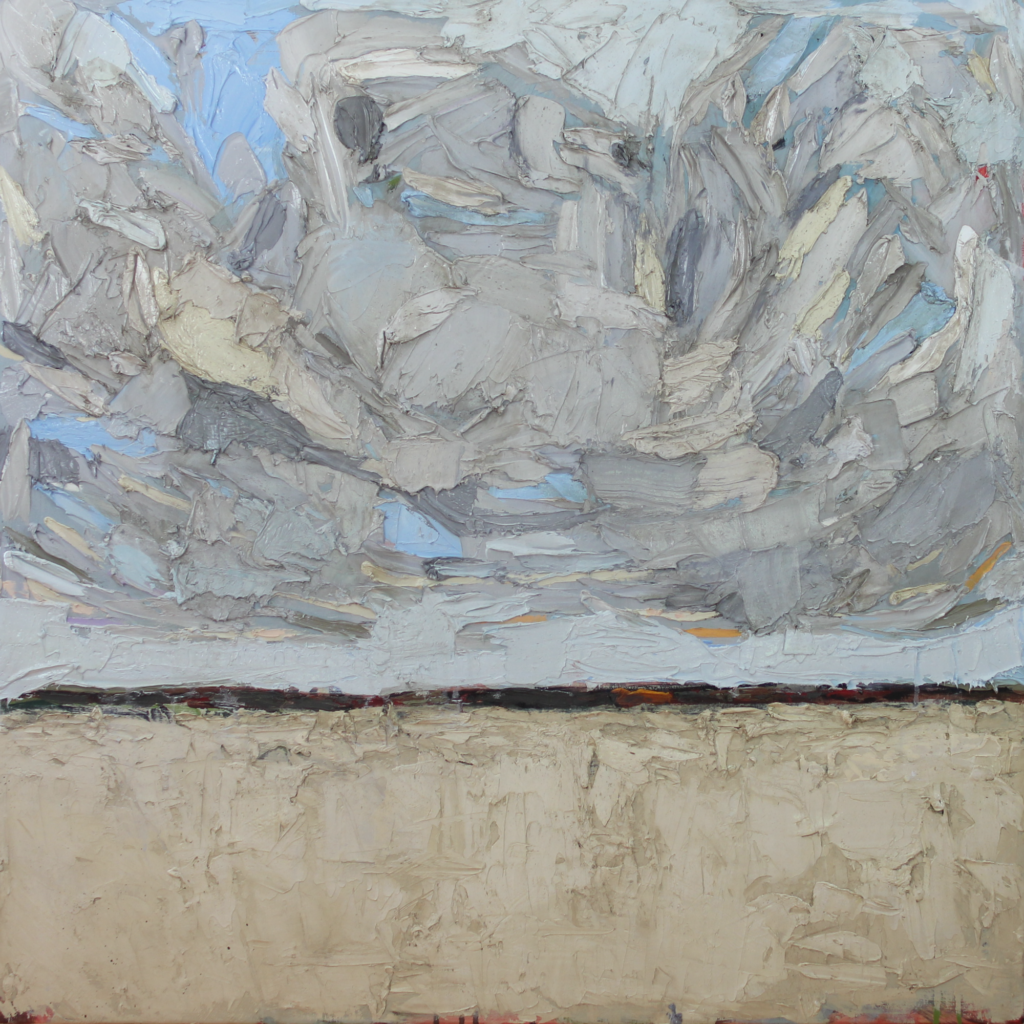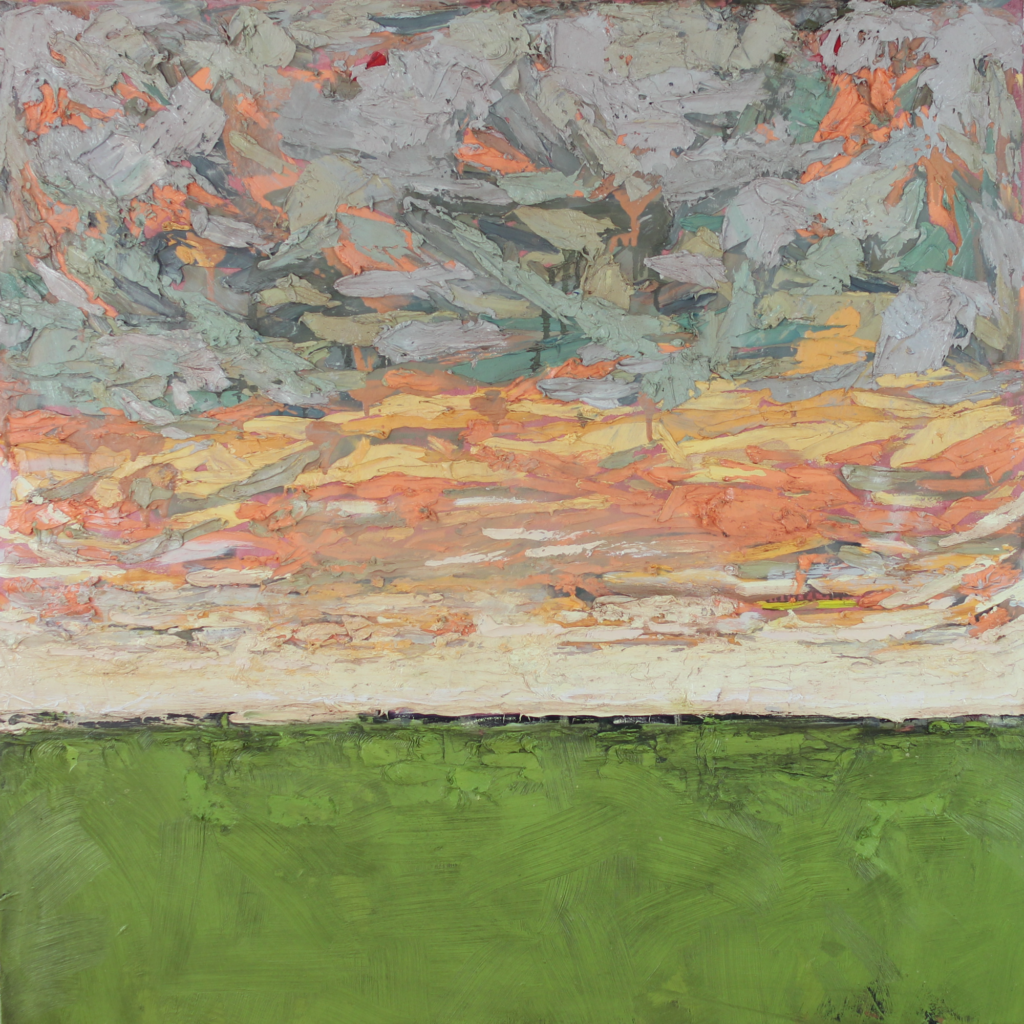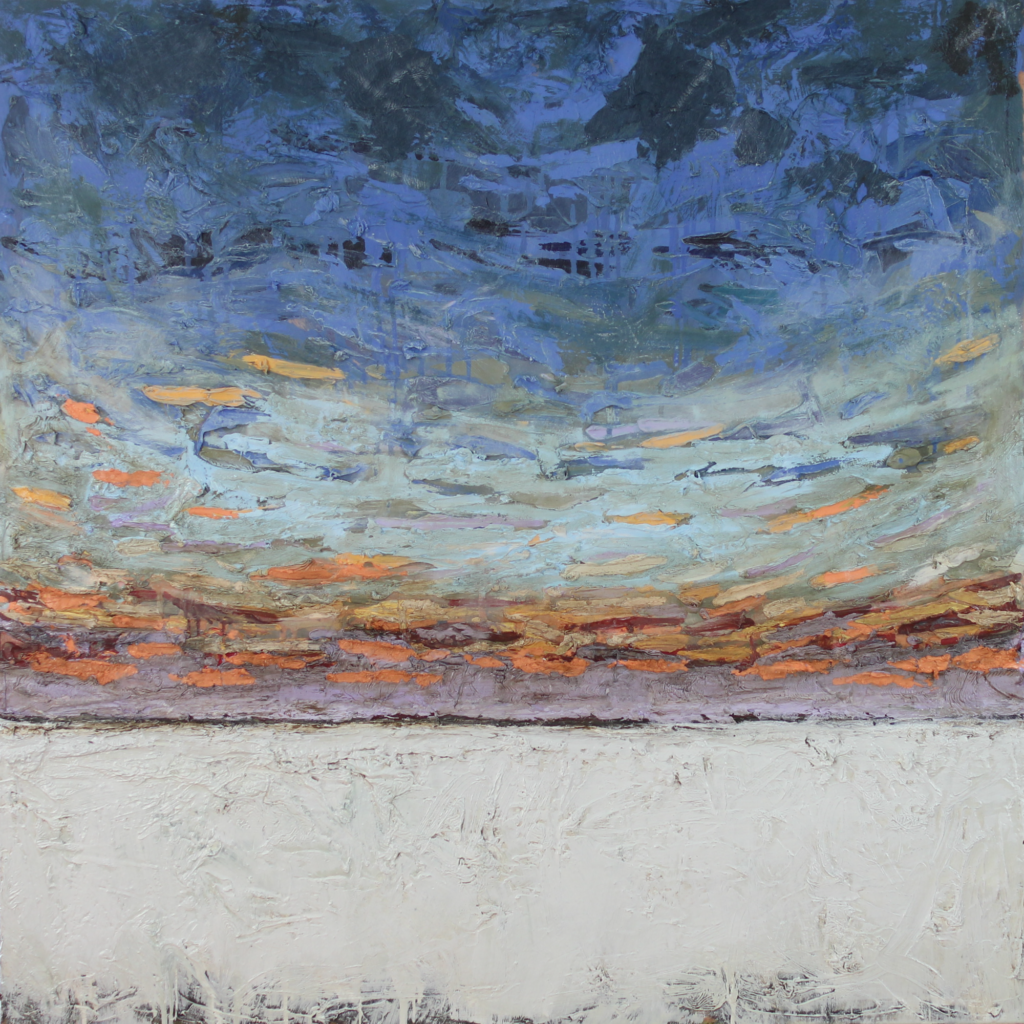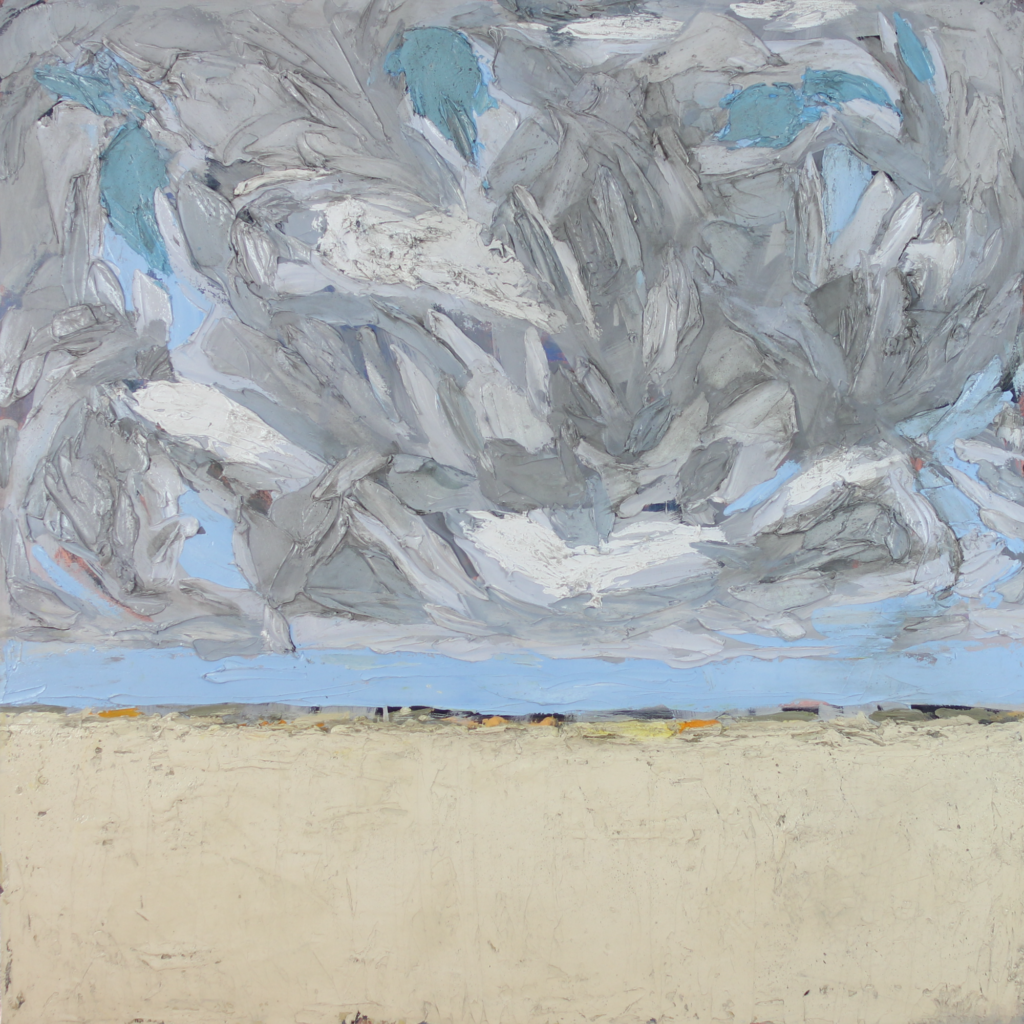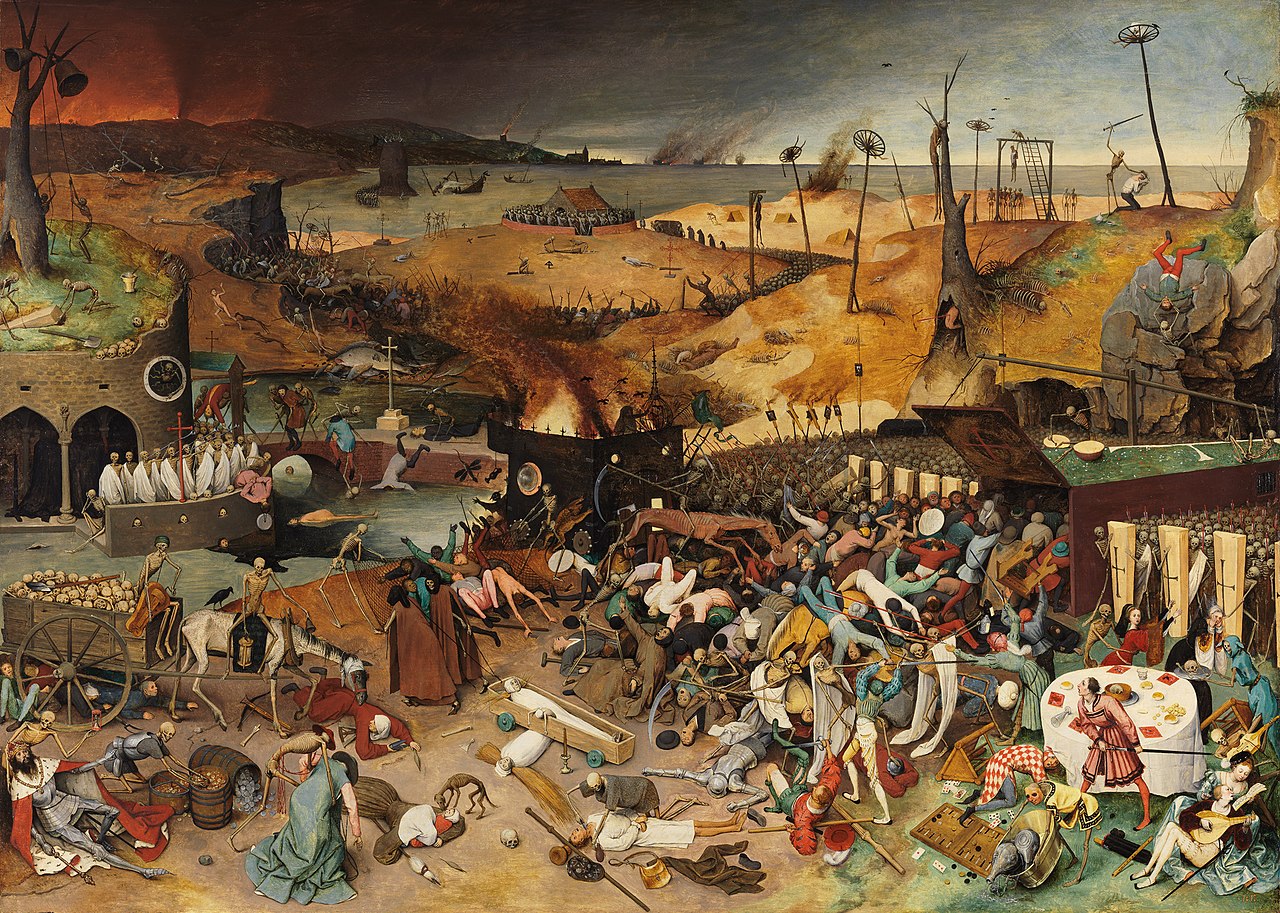
SHAUN WILSON: PLACING THE DECAMERON
This two-stage residency belongs to a wider investigation named Winter Light which examines the beauty and horror of plague and illness through contemporary art. Placing the Decameron deconstructs The Decameron, a series of novellas written by medieval author Giovanni Boccaccio around 1348. These stores digress seven young people sheltering in quarantine at an abandoned villa outside of Florence during the Black Death pandemic. The new works will situate the ten days of stories into a suite of ten works contextualising the backdrops of the Black Death and COVID-19.
PART 2 RESIDENCY (2022)
Last year (2021) I undertook Part I of the residency which at the time I considered a self-contained project. The issue was that the completed suite of paintings always seemed to be unresolved but the way to complete them wasn’t entirely clear. Over time, I’ve produced a series of doodles, notes, writings, whiteboard ramblings, NFT art, and digital studies that formed a developmental pathway to finding a resolution (I think). The answer I found was working in a diptych format with the mindset of taking what’s important about the Winter Light context, which in this residency’s standpoint is about the three aspects of The Decameron’s mechanics – the places, the event, and the ten narratives – and making a twin context where one painting has a conversation about the other and outcomes of such become the artwork that I’ll complete for this residency.
The new panels will be an amalgam of an image related to other historical artworks relevant to plague and illness, mainly etchings and engravings about The Decameron, screen-printed artefacts from plague bills of mortality, and roundel emblems based on autobiographical memories of illness. On that note, the last time I was in hospital as a child (as a long-term resident at the Children’s Hospital in Melbourne) my parents gave me two models of World War 2 era RAF Lancaster and Wellington bombers both of which had Type C1 roundels on their decal sheets and this image of the roundels bears a significance for me as the closing point of my childhood illness era. This meta-conversation about illness and place congeals the second panels and also has a conversation about the first panel which I’ll silkscreen onto the second as a collaged second-handed copy of the original. All of this surmounts a conversation about places and illness compounded back to the Decameron story.
WEEK 1
This week I began making digital studies of the second panels since my canvases aren’t arriving from the supplier until August. I’ll spend the next five weeks developing studies to explore the range of elements that’ll be juxtaposed into the final second panels. Here’s a mock-up of the first diptych that I’ll work on that takes the painting of the second day where Philomena is the storyteller of the day. It’s not necessarily the final decision but the start of the thinking process as to how best to make these paintings situate with the 2021 counterparts. One strategy is to examine working as straight colour reproductions of the source paintings versus a B/W pixelated version that I can manipulate with controlled applications of thick paint. It’s strange looking back at where the original paints began as I’ve continued to work on them over the Summer break into 2022. Many have changed, some dramatically, some only slight, but I’ll get into these stories in a few weeks once I’m back at the easel. I’ll also have much more content to post over the coming weeks but geez Im glad that this residency stretches out to the end of the year. Will try my best to finally resolve the works into a finished form. We’ll see how far I get on that one… It’s also great to be back at FAC.
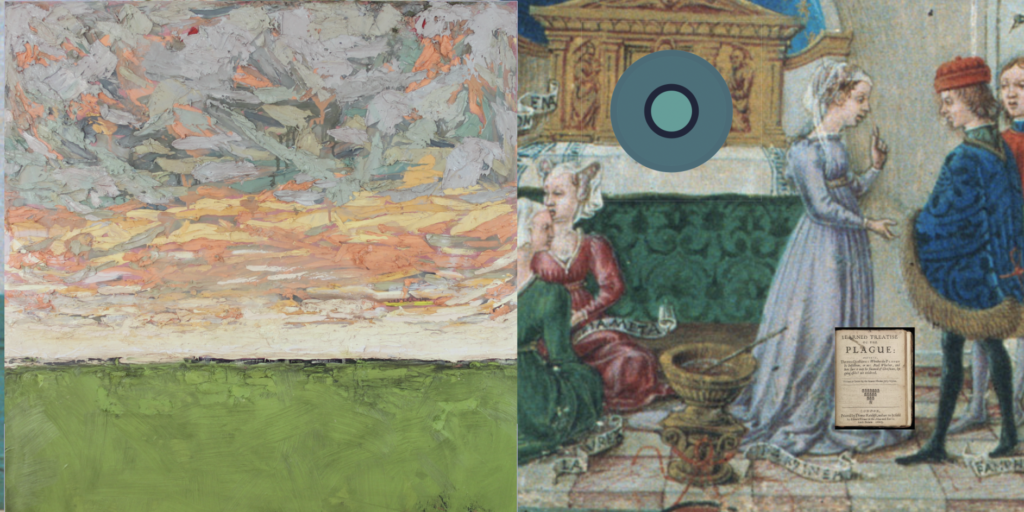
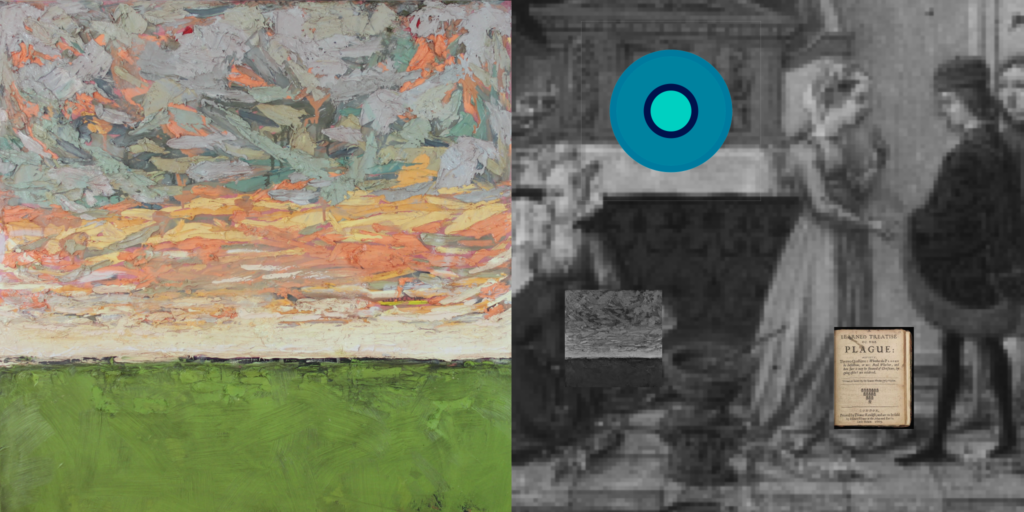
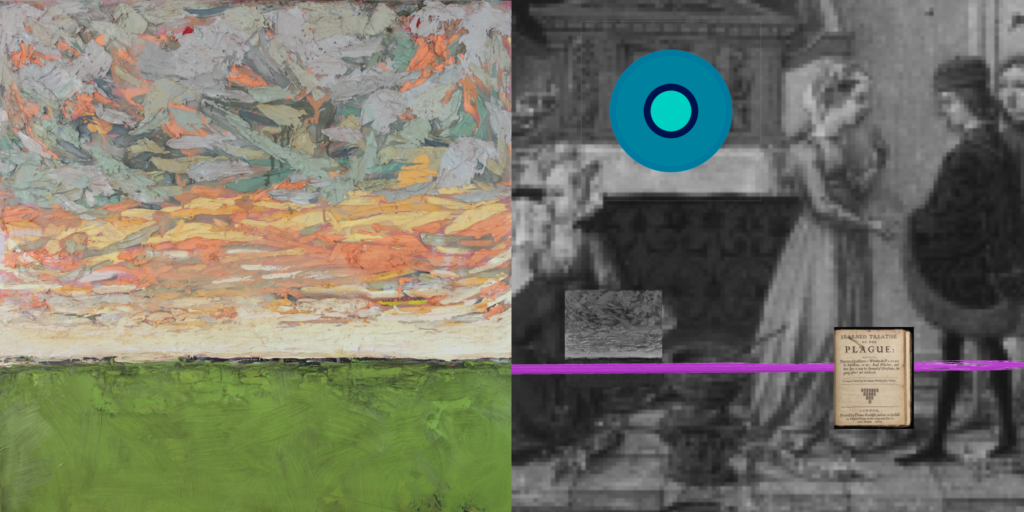
WEEK 2
This week I focused on the concept of relationships between the two panels and how the aesthetic and critical components of both are going to hold a conversation in transcribing the elements of the Decameron for the audience. Here are some of the working digital sketches I made this week which are also being developed for the project’s suite of NFTs. While I’m still developing the aesthetics of the second panels, I’m evaluating the idea of mono tonal values to see if it’s of any linkage with the left panels. These are more of my digital scrapbooks although I really should compile a physical scrapbook to explore more tactile approaches to the expansion of workflows as the prototypes gestate over the next few weeks.
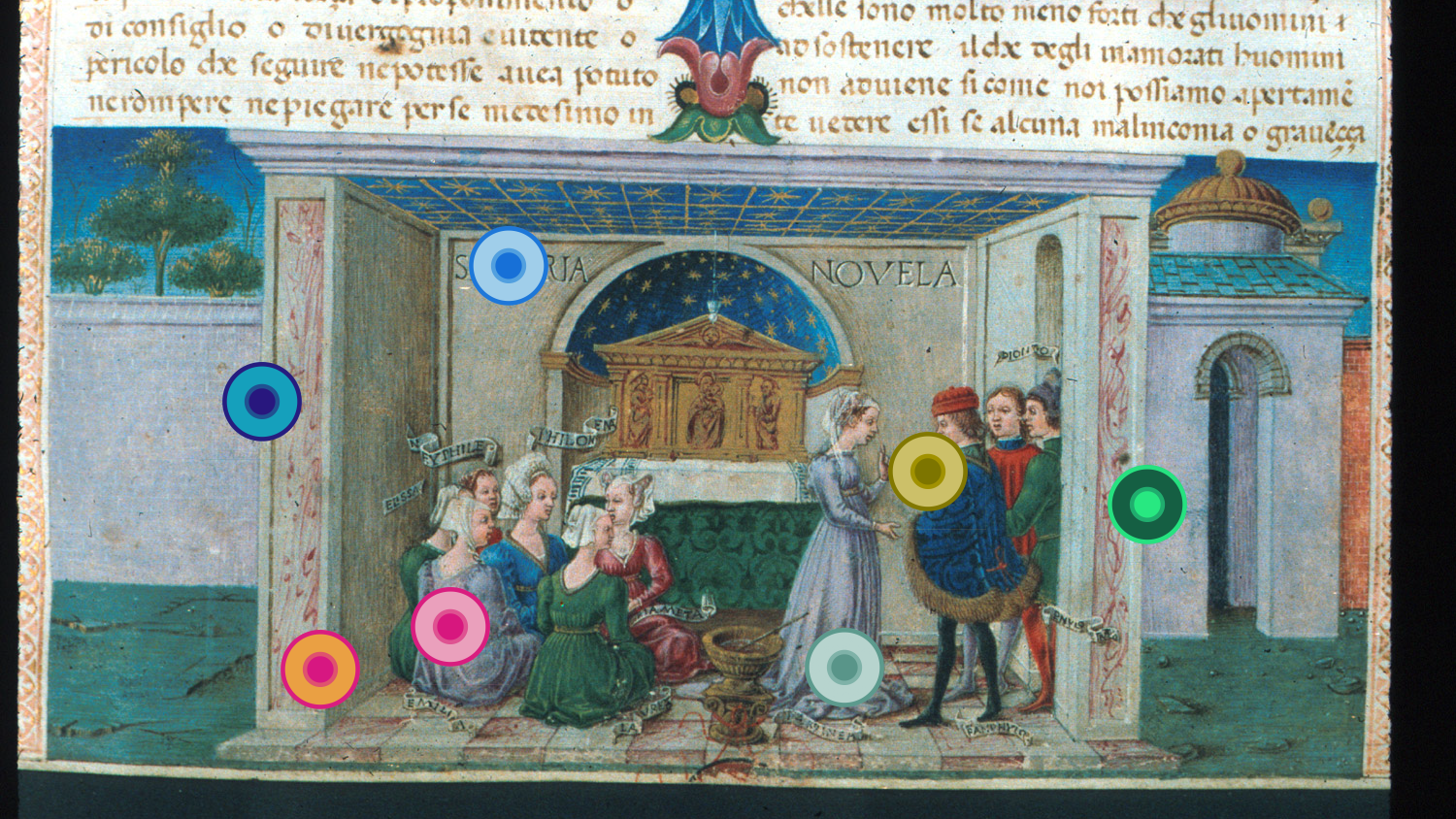
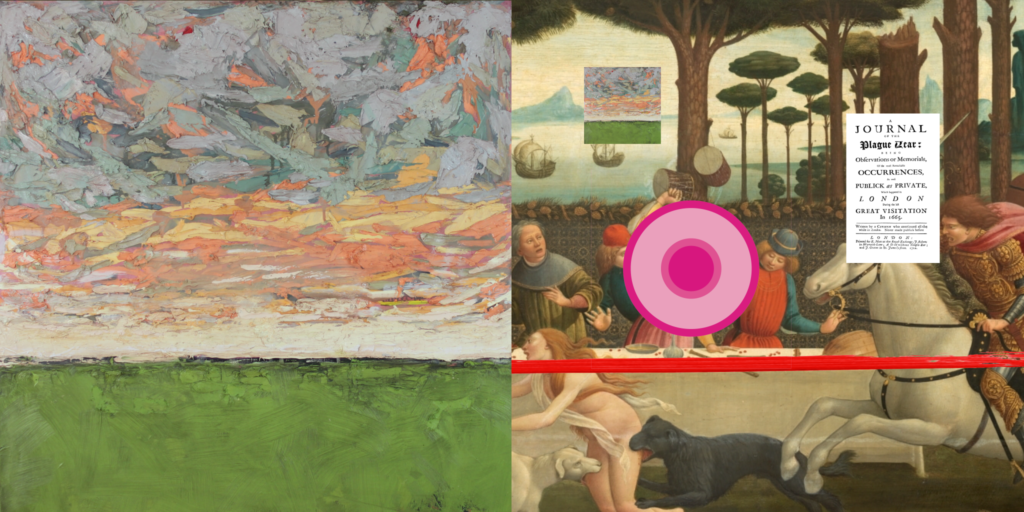
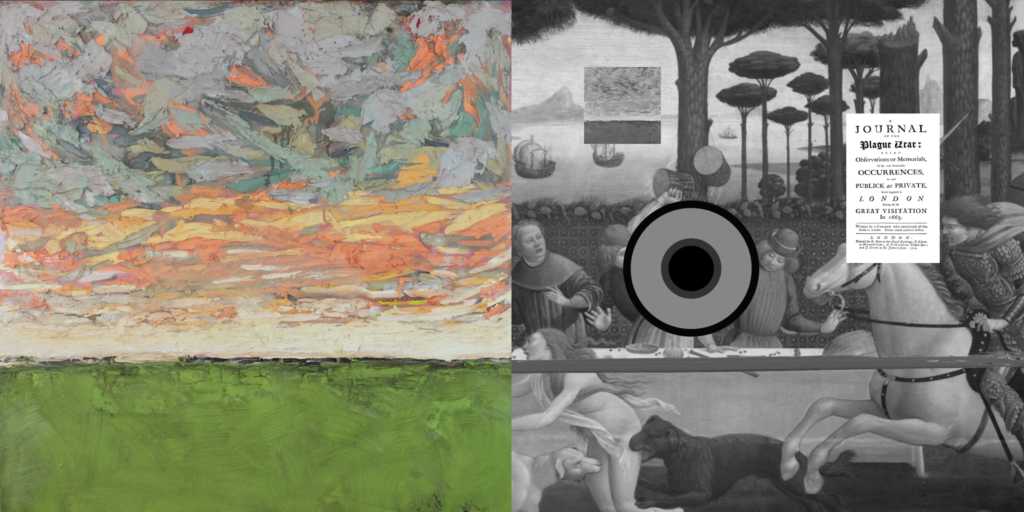
Week 3
This week has been focusing to develop the roundel motifs that’ll intersect in the panels as a motif bridging the personal narrative components of the work. These are the stamps that act as a reflection of self in the mix of the other signals used in the new panels. The histories behind such designs hark back to my last stay in hospital as a child where I would frequent the Royal Children’s Hospital in Melbourne with regular stints over three and four days at a time for the treatment of asthma. During the last stay in August 1984, I was watching the closing ceremony of the LA Olympics whilst building a Matchbox 1/72 scale miniature RAF Wellington bomber and was fixated on the roundel decals. I recall being drawn to the camouflage designs and motifs which have acted as a memory point that represents the closing of a childhood era of these hospital encounters as I never was admitted into hospital with asthma again. I tend to think of this last stage as having linkage with the comparisons with the COVID-19 pandemic where I’ve now gone back to face to face teaching this semester after two and a half years of teaching and working online. For me it feels like saying goodby to an impactful stage just as the hospital visits were the same for my younger self at that time.
These roundels are inclusive of representing a closing of an era that it just seemed to be natural to include in these new second panels as the narratives of illness through the Decameron now have my own story of isolation and illness as well. Below are some of the artworks from the model kit I was building at the time and I’ve sourced the exact same artwork that was on the box of the model kit I was constructing in 1984. For technical reasons, it’s also called the Type IC design used by the RAF until 1947. I’ll base this design within the new works and explore more ways to incorporate colour field aspects into the paintings as one of the many signals (in a Baudrillard sense). Below is an example of my own designs responding to the meta-memories of the hospital model kit.

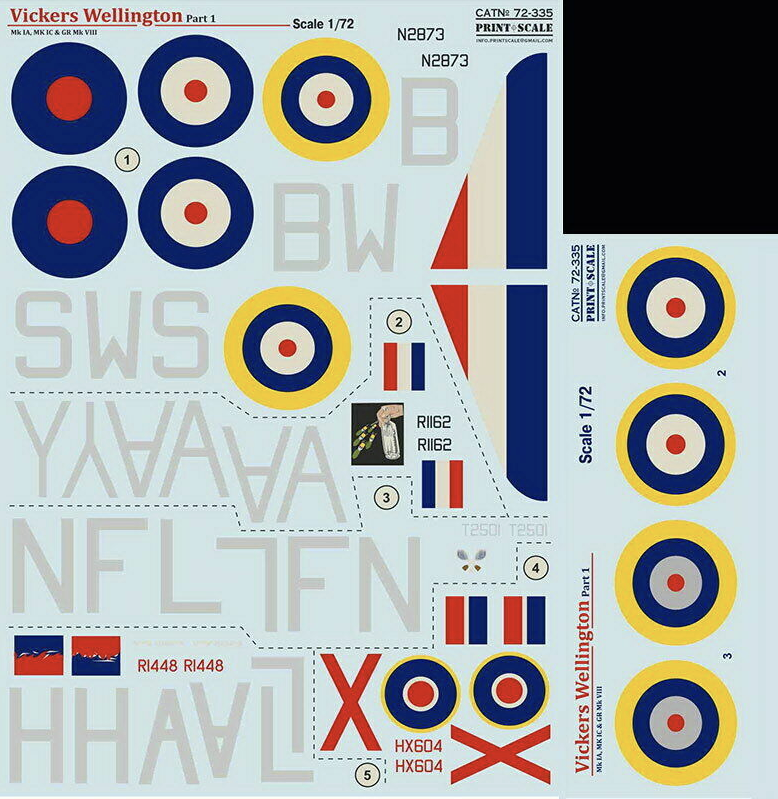

PART 1 RESIDENCY (2021)
WEEK 1

The initial story of the Decameron presents a group of seven young people fleeing the Black Death in Florence to a deserted villa where they held up for two weeks and concocted the 100 stories. This first work presents medieval Florence at the start of the plague spreading within the city walls. From an aesthetic perspective, I drew reference from some of Chagall’s early lithograph works especially winter scenes by Russian print makers in the pre-revolution period. I use the concept of winter as an allegory for the coming of plague which has it seems o be a commonality through my COVID-19 themed works from last year and into this year. The work is a culmination of hundreds of layers of acrylic and ink washes, charcoal, and medium rubbings that makes the paper on completion feel like leather. The photos don’t really do the work justice as my phone camera tints a heightened contrast level but you get the idea of where they’re going. I’m attempting to produce one of these artworks every week created mostly late at night in my studio. The image is based on a landscape painting of Florence during medieval times where I’ve taken care to note the terrain and walled city elements as they would have been at the time of when Boccaccio started to write his novellas.


WEEK 2
This week’s work focuses on the introduction of the second day as Boccaccio describes the group led by Filomena venturing into a shady meadow where she orders Neifile to lead the days stories. I was drawn to the idea of representing landscape as the background of where these stories unfold. An aspect that I’m most interested in is the role that place intervenes within the groups of stories. In this instance, not only is place itself an overlooked aspect of the Decameron, but rather it establishes an important experience for the ways that the stories are manifested over the duration of the ten days which, moreover is simply ignored throughout critical readings of the book. The role of the meadow in the structural effacement of the ten stories contributes to the way that each story is later told and experienced. While each story has its own imaginative place mapped into the specific narratives unfolded, the mechanics of such are dependant on place thus intertwined within both the story and the narrators of each instalment.
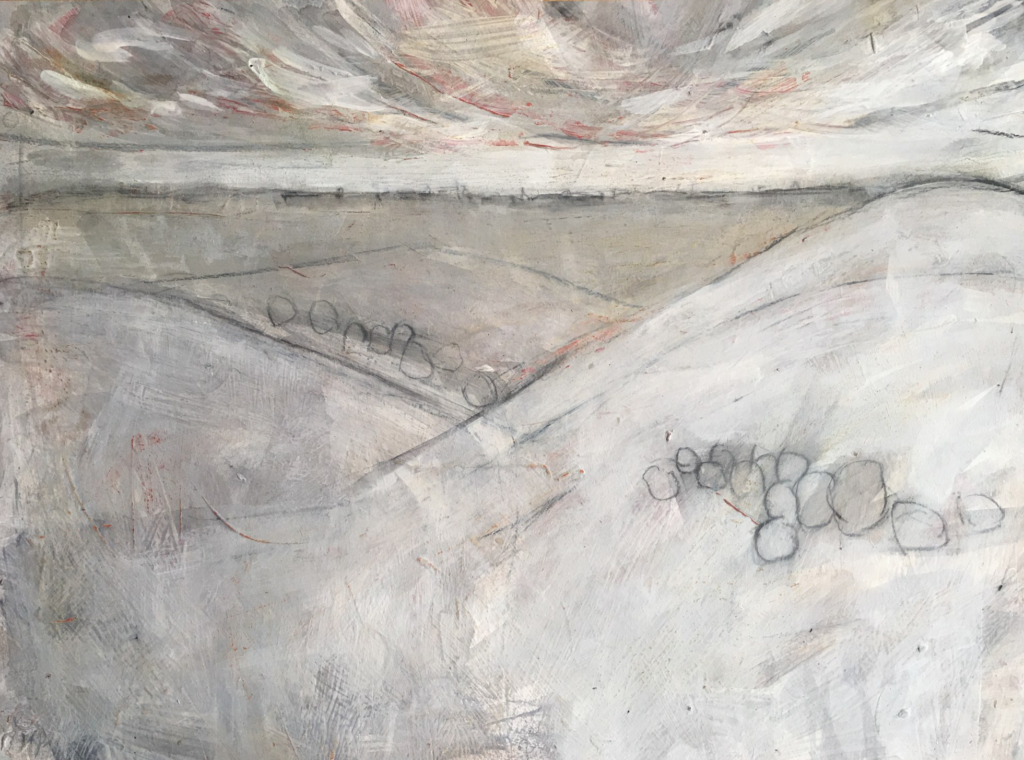
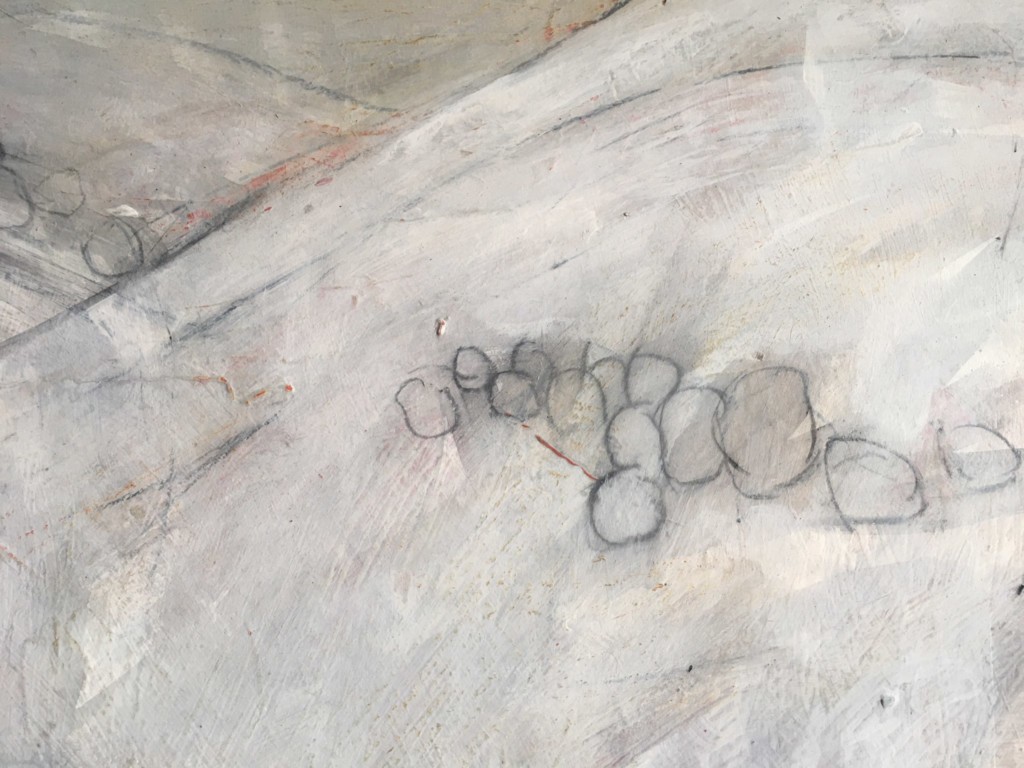
WEEK 3
I’ve spent three weeks trying to develop drawings that failed miserably (and have been delayed due to a COVID self quarantine when I visited a regional Victoria COVID site – art imitates life or life imitates art, whatever way you think of it ). After numerous attempts at failures and uninteresting compositions, I’ve found that oil painting on canvas opened up a way to convey what I was trying to achieve that the works on paper could not. So… I started painting and found the barrier for me in the drawings was the lack of dimensionality and volume thats present in oil paint, being my native medium. In essence, I found that there were two main barriers, the first being the texture and volume of oil paint offers something for me that drawing lacks, and second is that the project so far has revealed a need to consider the emotive context of the locations of each day’s story telling rather than merely addressing the sense of place in these daily rituals as a pictorial representation. The new works are on stretched canvas measuring 100cm x 100cm each and I feel like, although costing me a fortune in art materials, by changing the medium I can now focus on the emotive connectivity of these locations in ways that are more aligned to how we connect through place, that is, through an emotive connection rather than a figurative spatiality. Here’s a revisiting of leaving Florence for the tranquility of rural outskirts. And the scope of the paint application, being more like ice cream than pigment, is free of impasto additives and 100% paint. It’s luxurious and at the same time ridiculous in how many litres of paint that I’m going through, but, things are finally working.
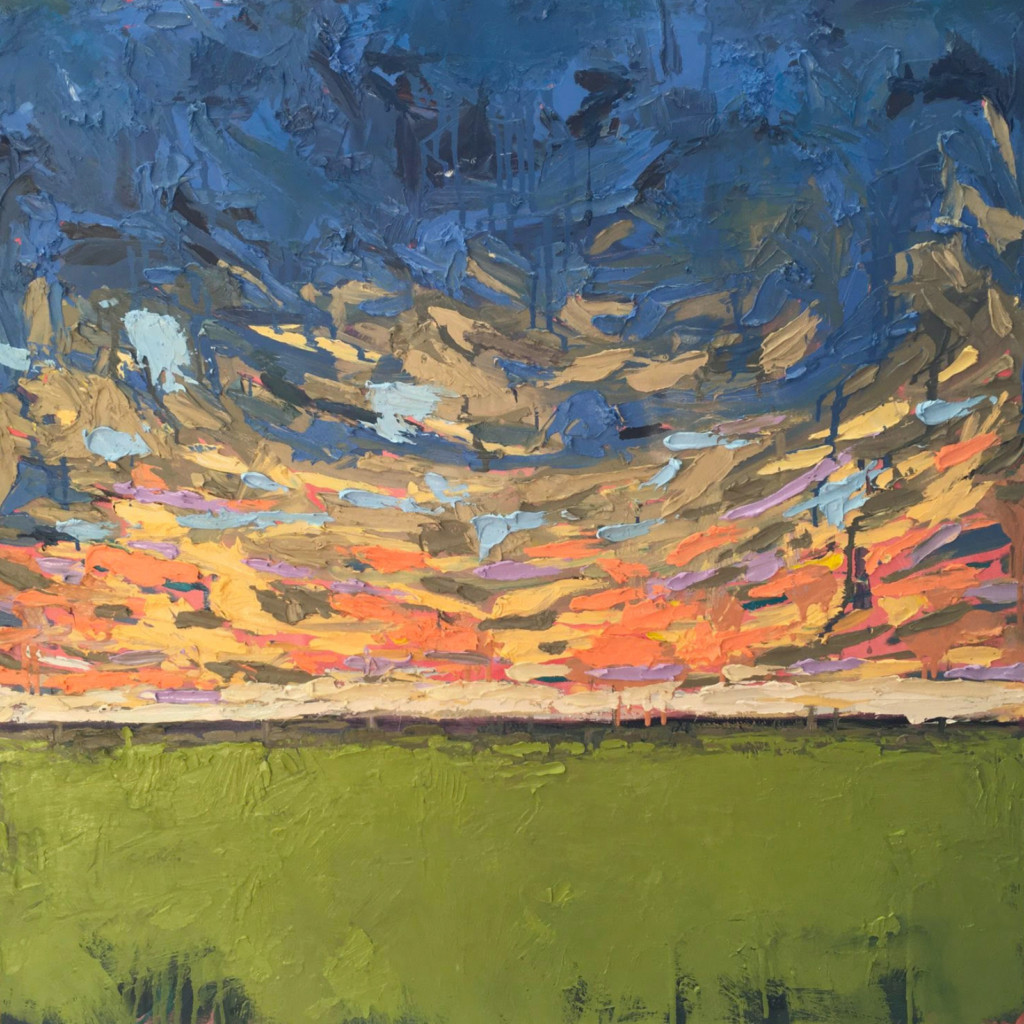
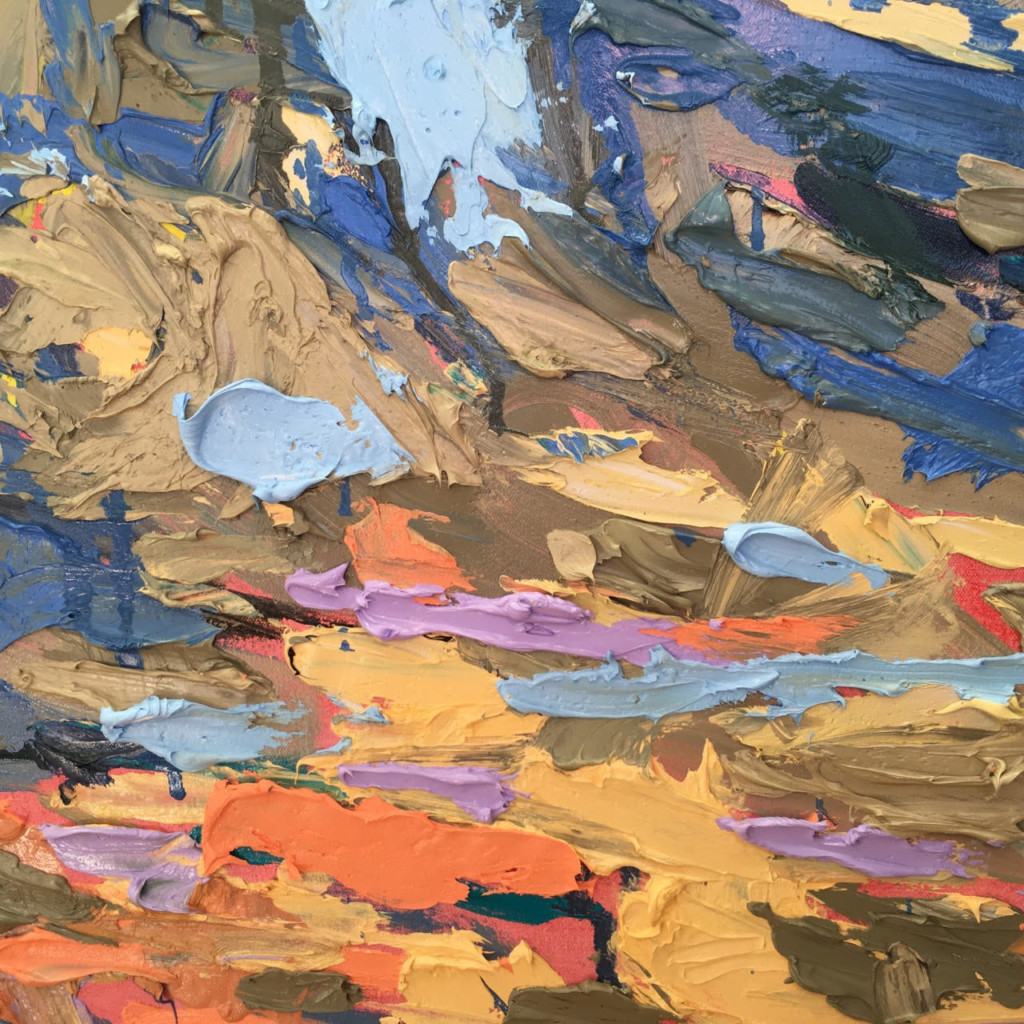
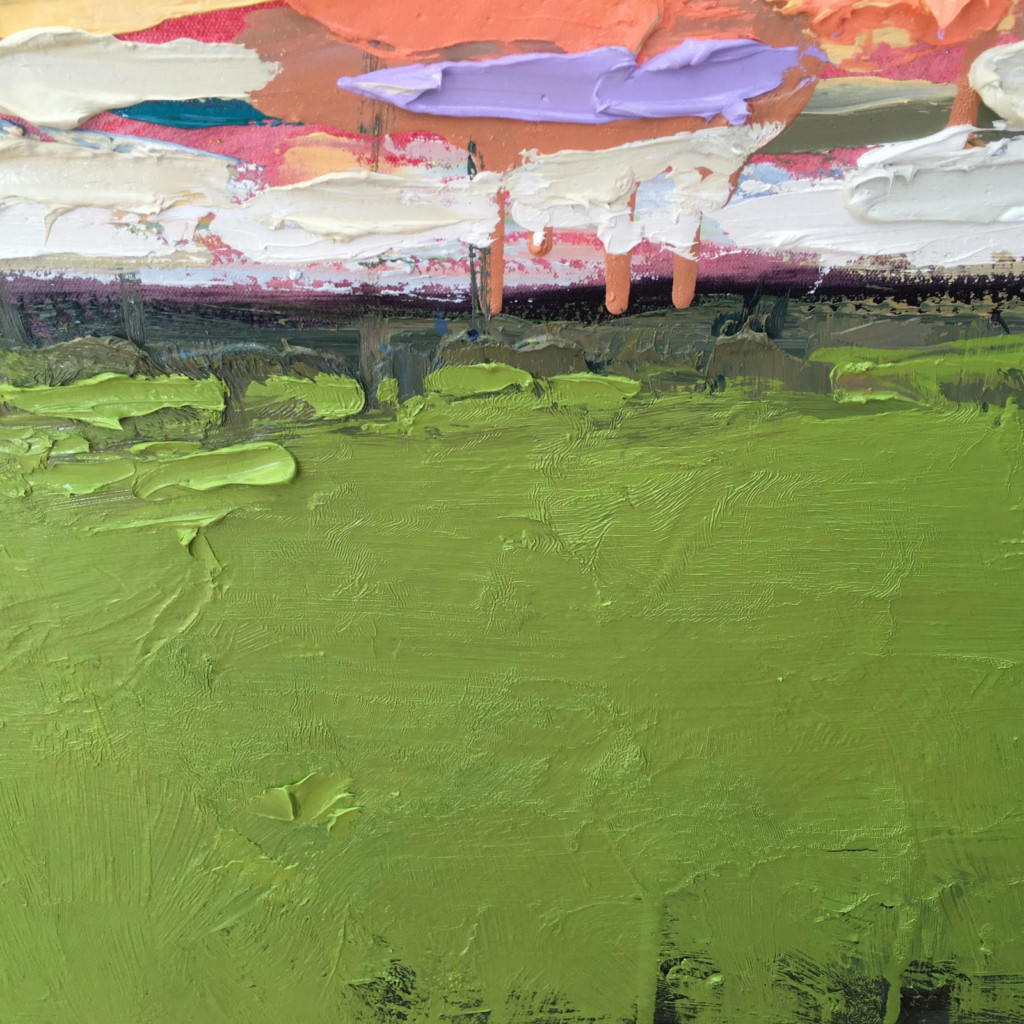
WEEK 4
In this week’s painting, I’ve gone back to reconfigure the second drawing in a way that conveys the sense of place in Filomena’s day of story telling that was lacking in the first. In the second day of the book, it describes a meadow and atmospheric effects of morning that I’ve represented here by paying attention to a morning sky using a newly formed palliate combination of oranges, Naples yellow, and greys. These are all referential in the Boccaccio description of what the meadow was like on that morning described in the introduction of Day 2 and I wondered what it must have been like through the seven participants view, escaping the plague ravaged city to the tranquility of the colours present in the Italian landscape. I lost count how many layers that this painting has, maybe twenty of thirty underneath what you see on top. And in doing so, I’d forgotten what it’s like to consider the landscape in context to oil paint – warms and cools, the state of light, contrast, hue, and colour relationships. In this one especially, I’ve become attune to some of the colour work in Post Impressionist works, especially Seurat, and also how Pointillism could lay two colours next to each other but the human eye would read a completely different colour than what is evident. This is much akin to plague and the effacement of lockdowns where the emotional tonality of a society in restriction blends into a monochromatic quagmire. I’m still learning how to paint again as I go, its been a while, but here are this week’s efforts.
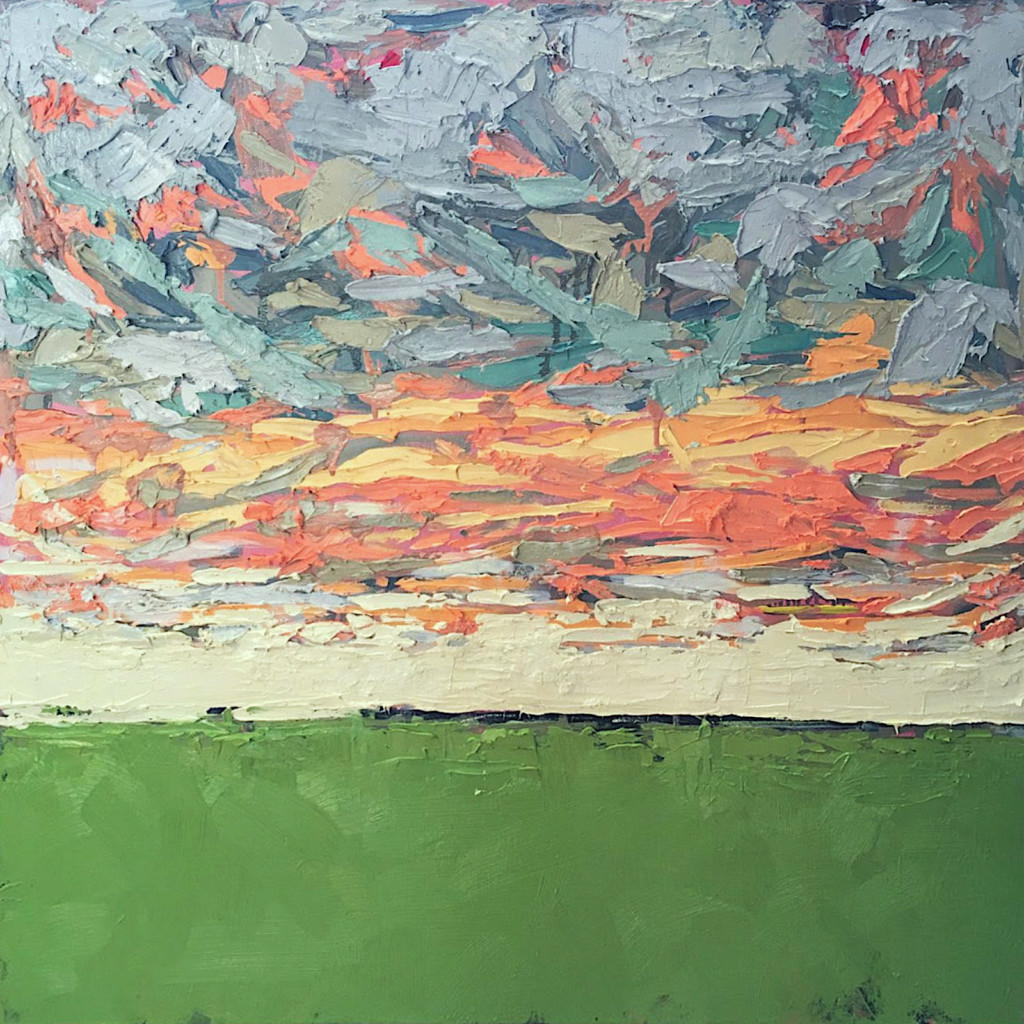
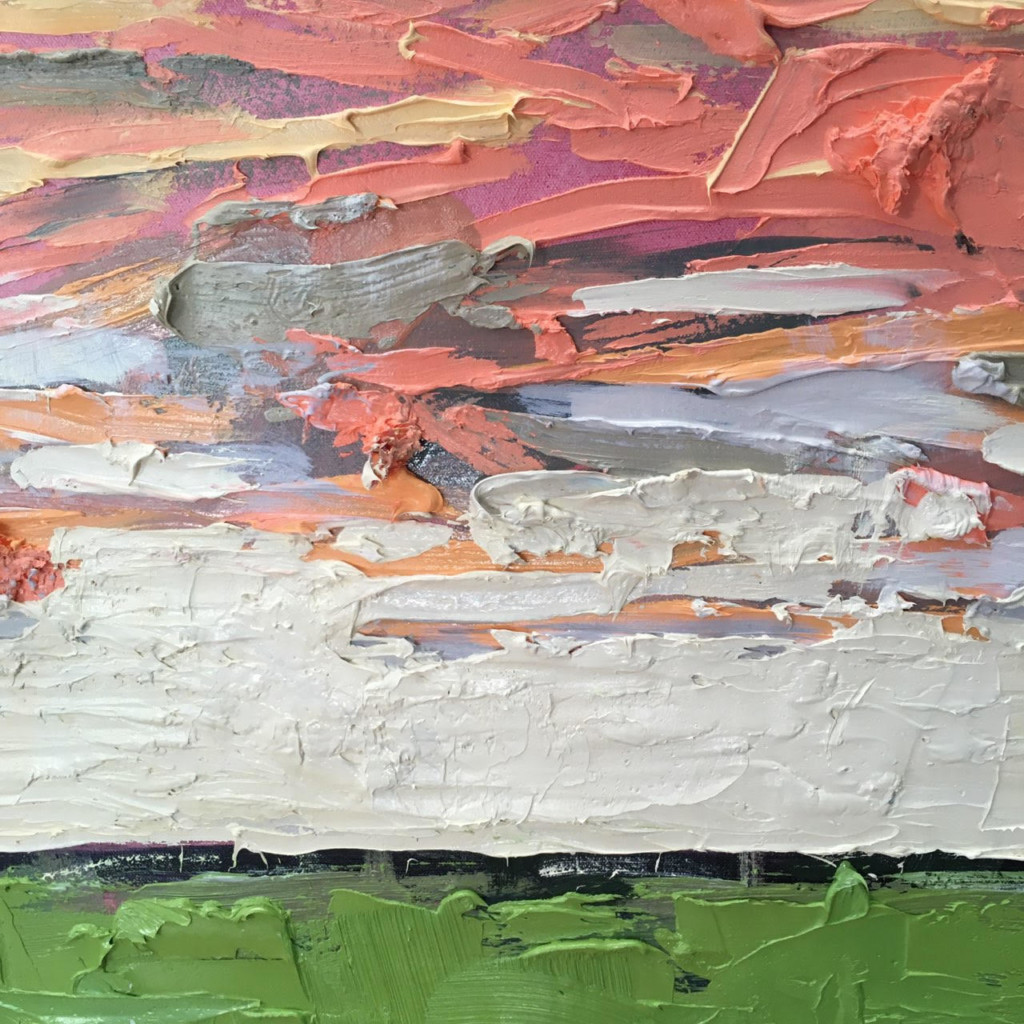
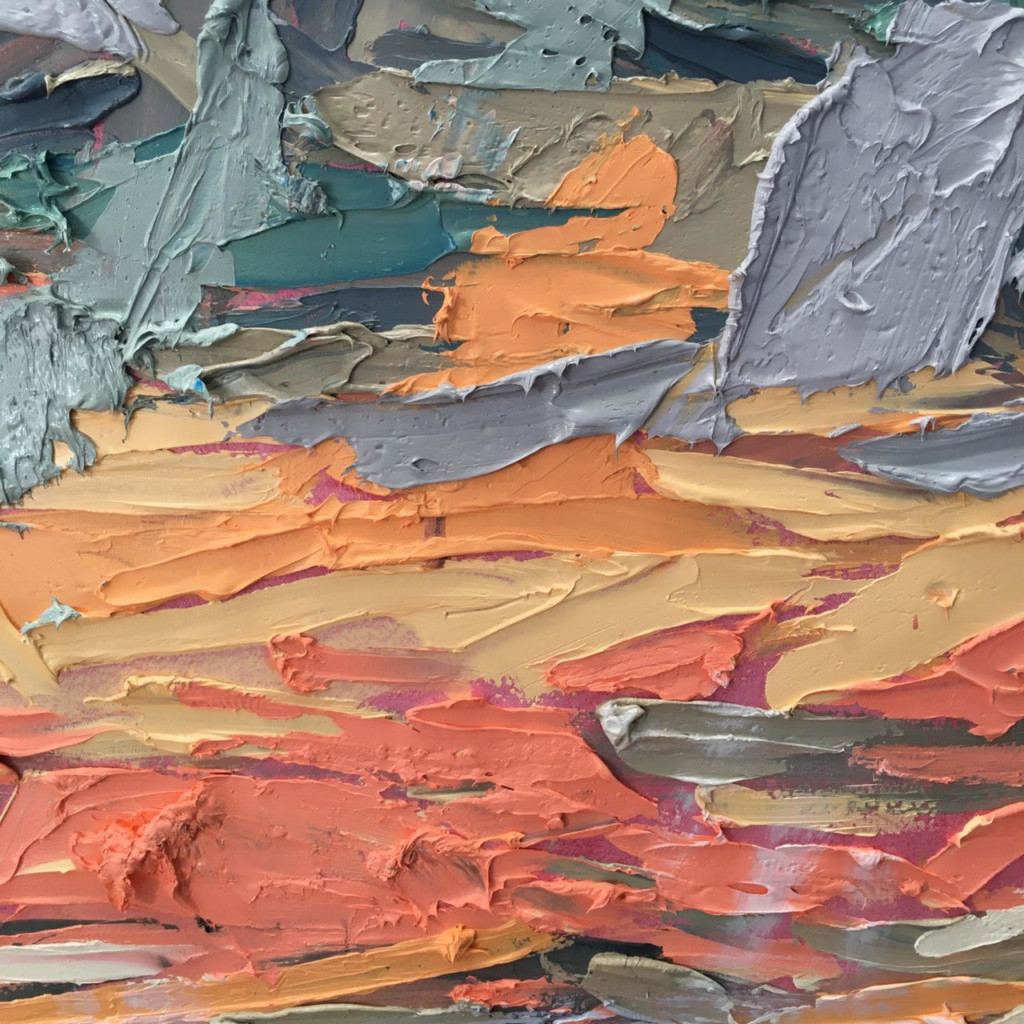
WEEK 5
This week’s painting has been tasked to apply more attention to light, especially around the third day of story telling. Boccaccio mentions a green garden filled with lush plants opening up the scene for the later heat of the day. Since I’m trying to avoid depictions of actual things and fixtures; instead to pay closer attention to colour and light, this week’s painting brings with it a depiction of the atmosphere esteemed from Filostrato’s day of stories. Here, the garden is represented by a green pictorial plane and the atmosphere especially in some of the day’s later events correlates to the broader brushstrokes and palette knife work thats a slight contrast to the smaller and narrow flicks used in the gestural marks located in the previous week’s paintings.
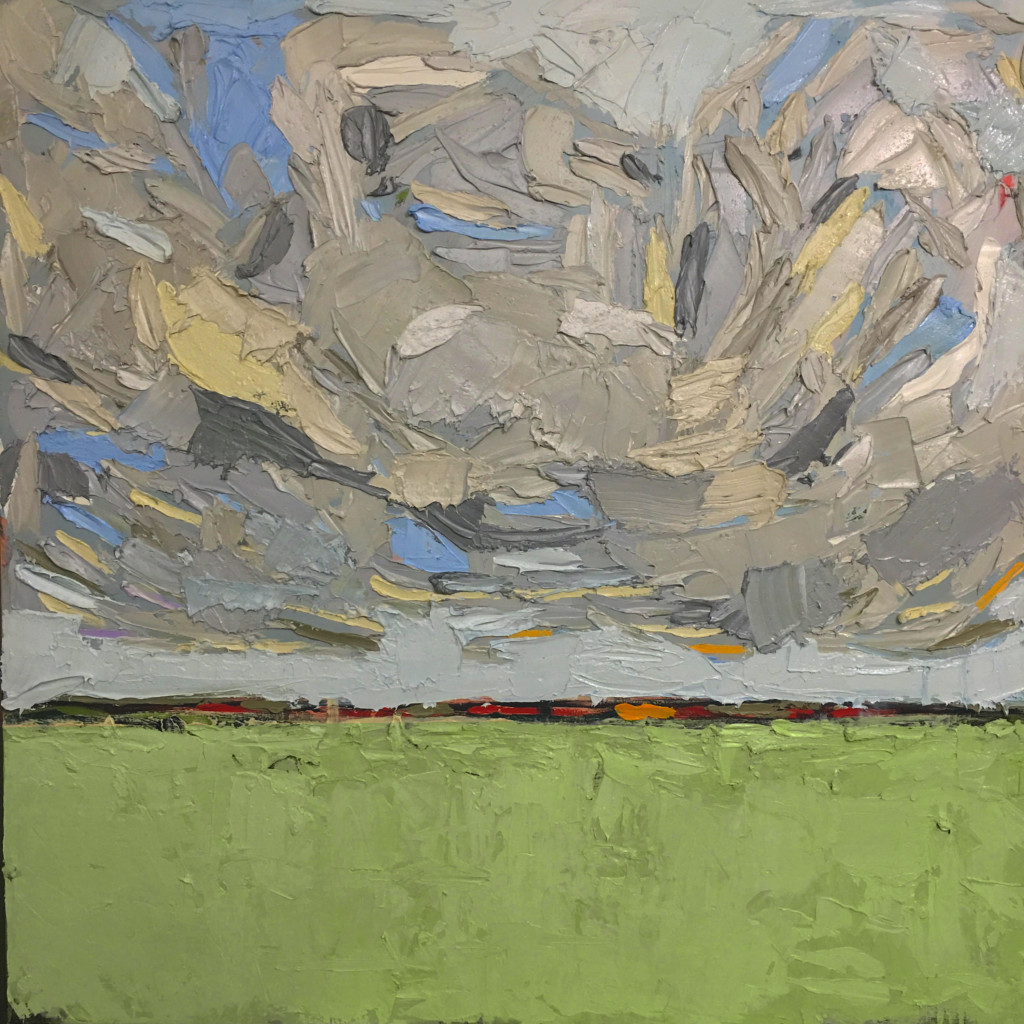
WEEK 6
This week’s painting examines the fourth day of story telling. It begins with Filostrato as ‘they speak of those whose love came to an unhappy end… [where] the sun had already chased all the stars from the sky’. (Boccaccio, pp.300-307) The places he describes feature the sun dipping after lunch where the group naps then proceeded with story telling. Within these stories, the mood changes to unhappy endings and I’ve reflected the agency of these narratives in the change of tones, especially in using more greys and Phthalo Blue tinges.It’s also the first time that I didn’t use green as a base.
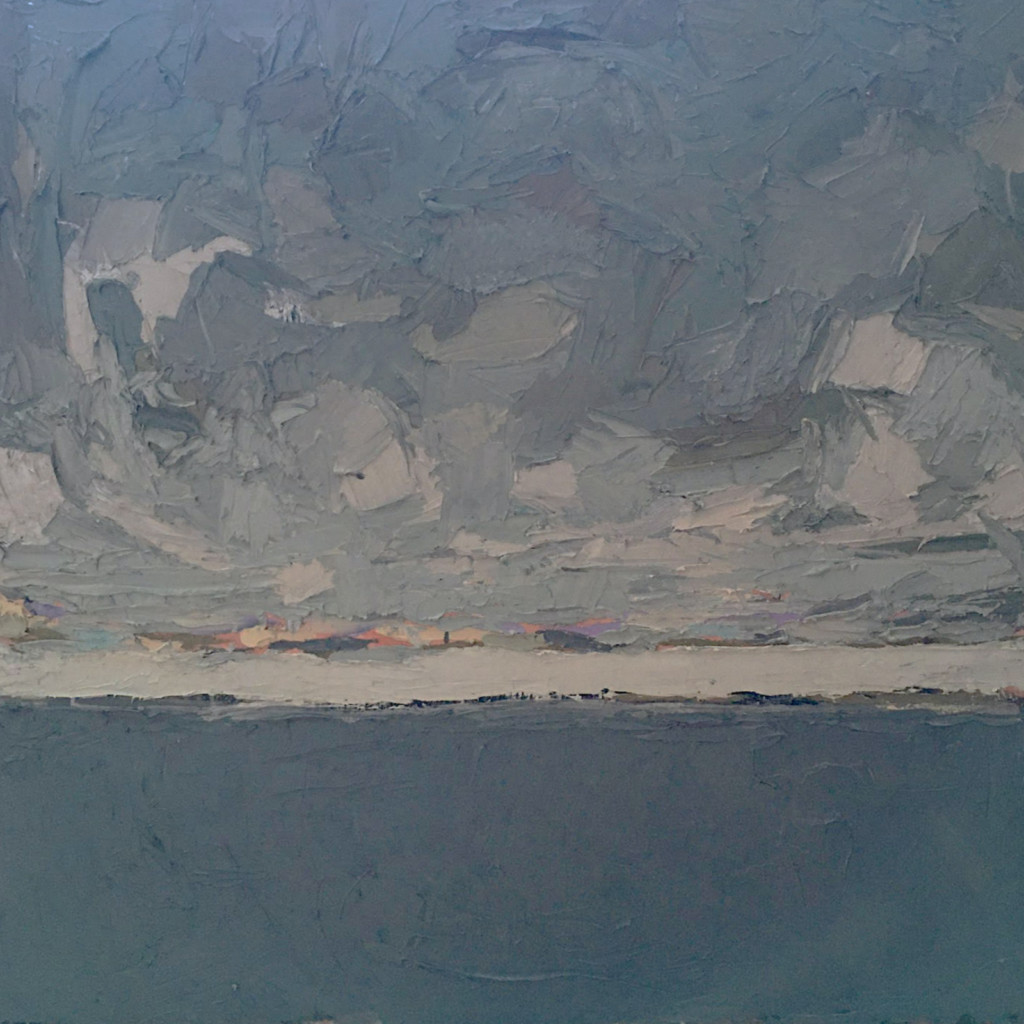
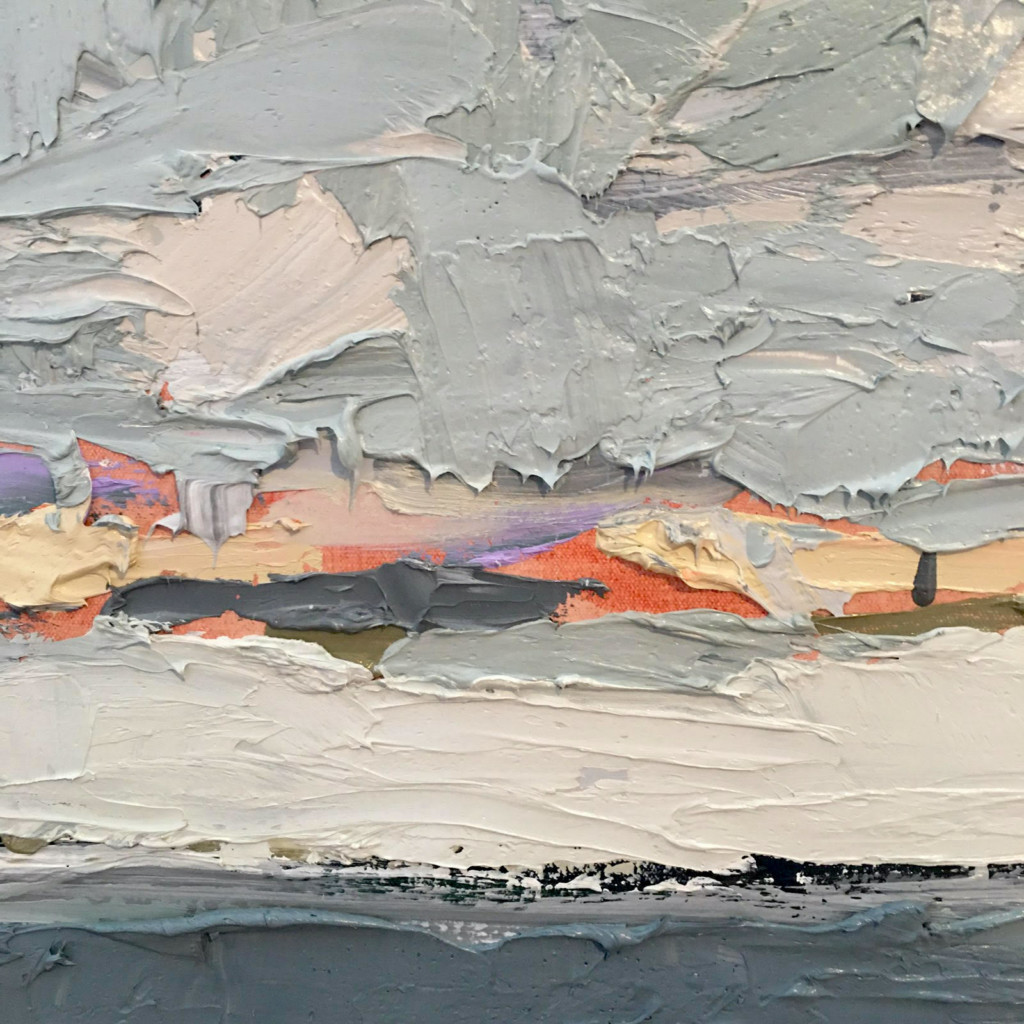
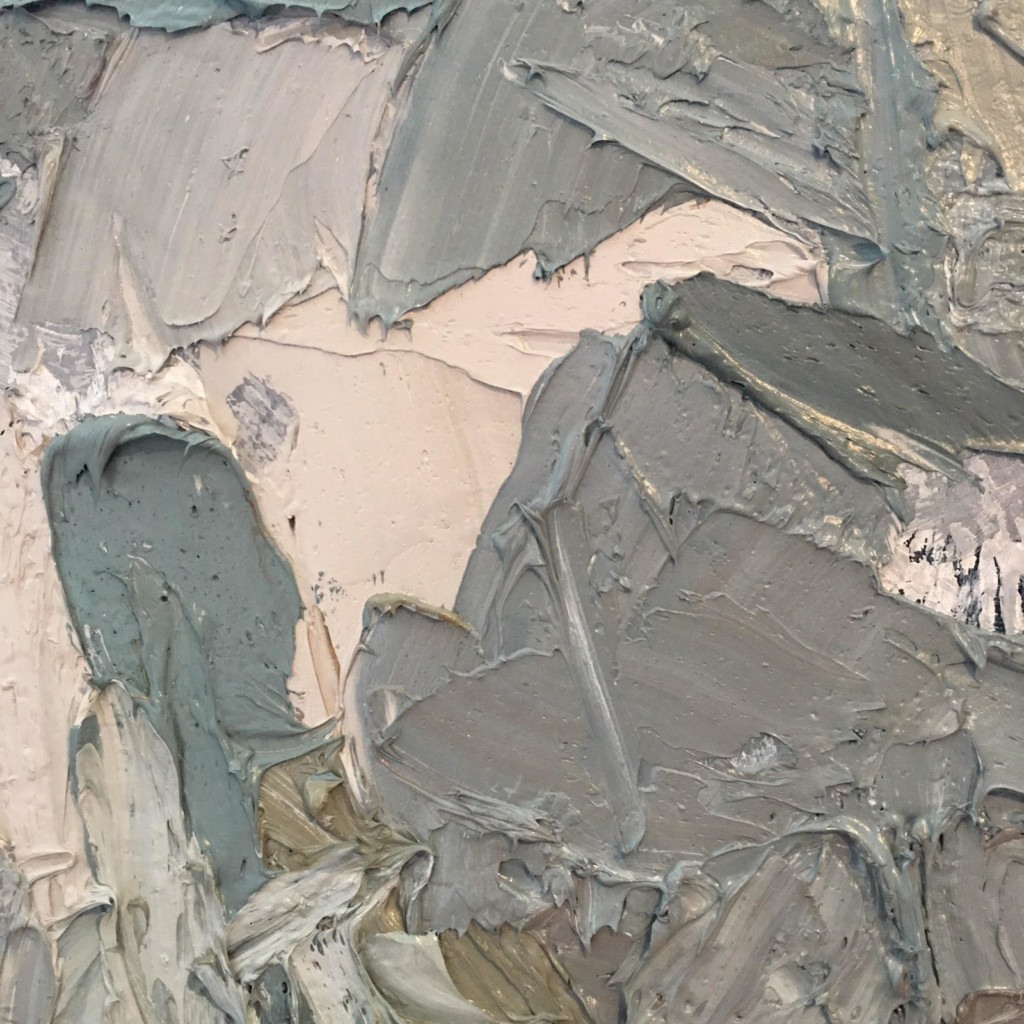
WEEK 7
I’ve been working on some larger scale paintings of the Villa meadow and also reworking the existing paintings done so far with raw umber washes to bring out an antiquity in the painting surface. One of my many criticisms of the paintings is that they’re too clean. I’d imagine that over the next week I’ll be attacking everything I’ve made in the current series to bring out an aged feel to the subject. I like the idea of destroying surfaces in order to bing them back. The allegorical aspect that emerged this week is treating the flowers in the meadow like a remembrance field much like poppy fields in battle paintings of the Somme. The investigatory aspects of the residency are opening up new series of possibilities as learning milestones gained through making mistakes. I’ve also located a makeshift tripod to hold my phone. Expect a lot more studio shots to come. These are the challenges of working solo in lockdown. My youngest daughter Sophia who is also a painter, and perhaps much more astute in the medium than her father, decided to pitch in and film some new video documentary material for me that you’ll see over the next week. I’m also getting a bit eye weary of raw timber on my studio walls. I might do some interior decorating this week?
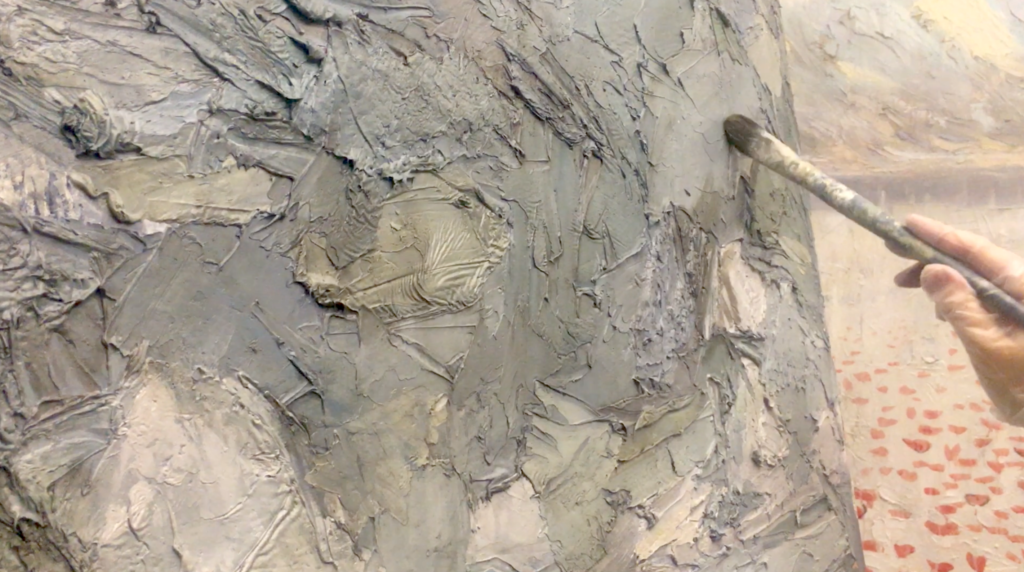
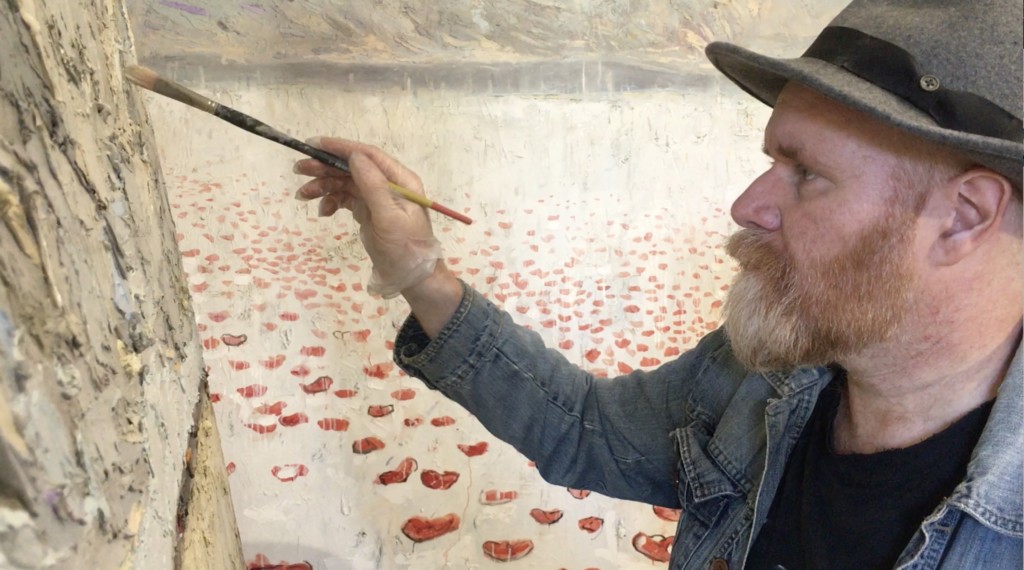
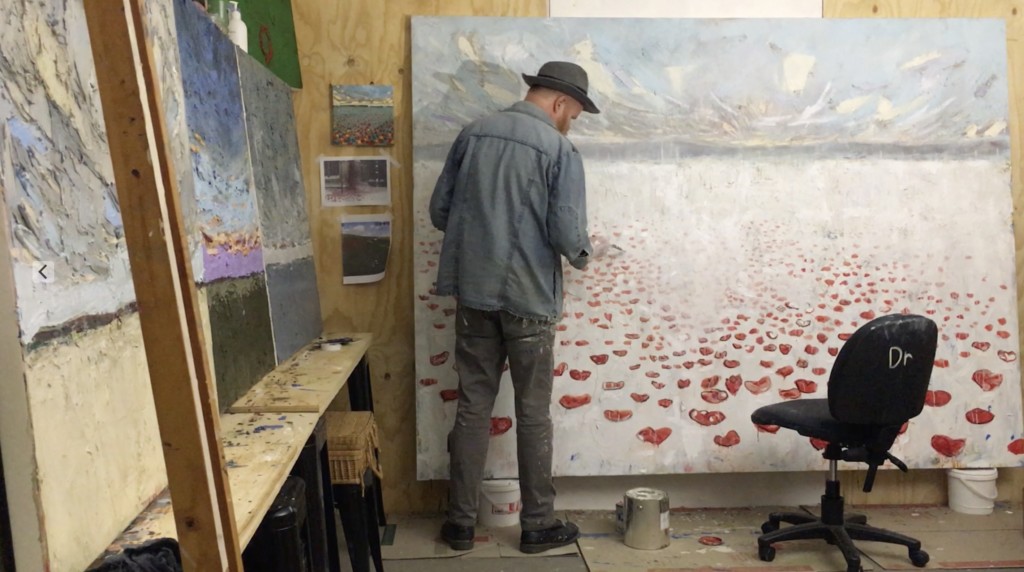
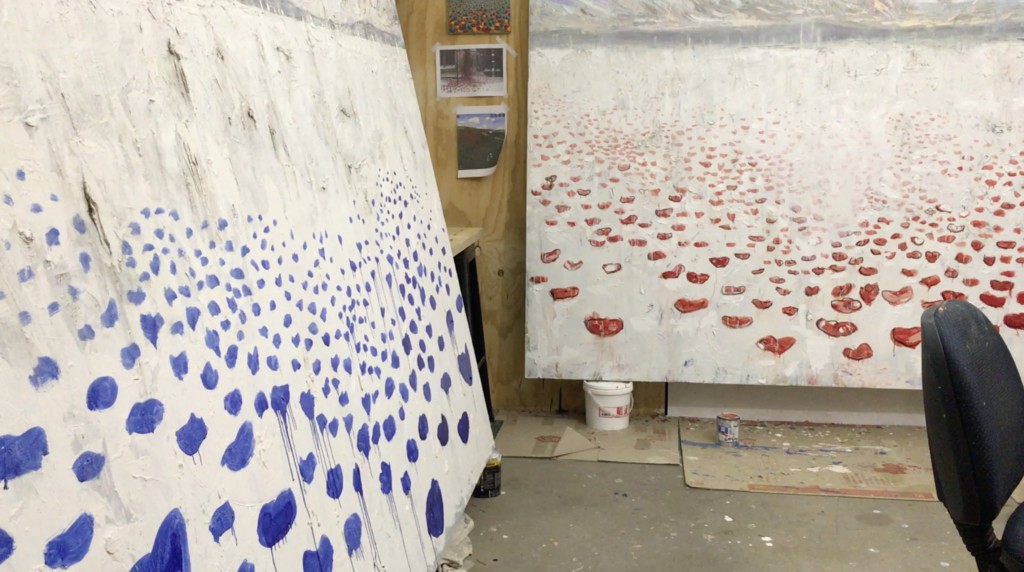
WEEK 8
I love painting except waiting for them to dry. And these paintings usually have between 2-3 kilos of oil paint per canvas. So there hasn’t been much progress this week apart from finalising five of the eight paintings with a few umber washes to give the paintings an antiquity aesthetic. The Poppy series is progressing more so as it’s the only task I can keep on moving forward with this week until the other three paintings dry. I’m sure that the villa storytellers had slow days although I suspect that a group of ten, rich, obnoxious kids squatting in a luxurious villa in the middle of the Black Death might have had the same problem. Here’s a pic of me in the studio this week and a video I made from my first residency chat sessions.
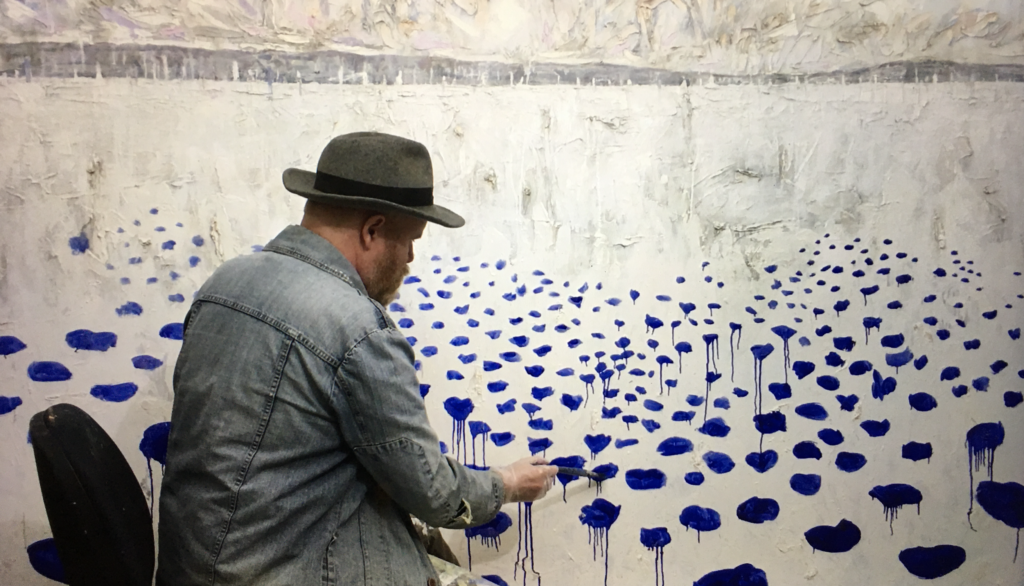
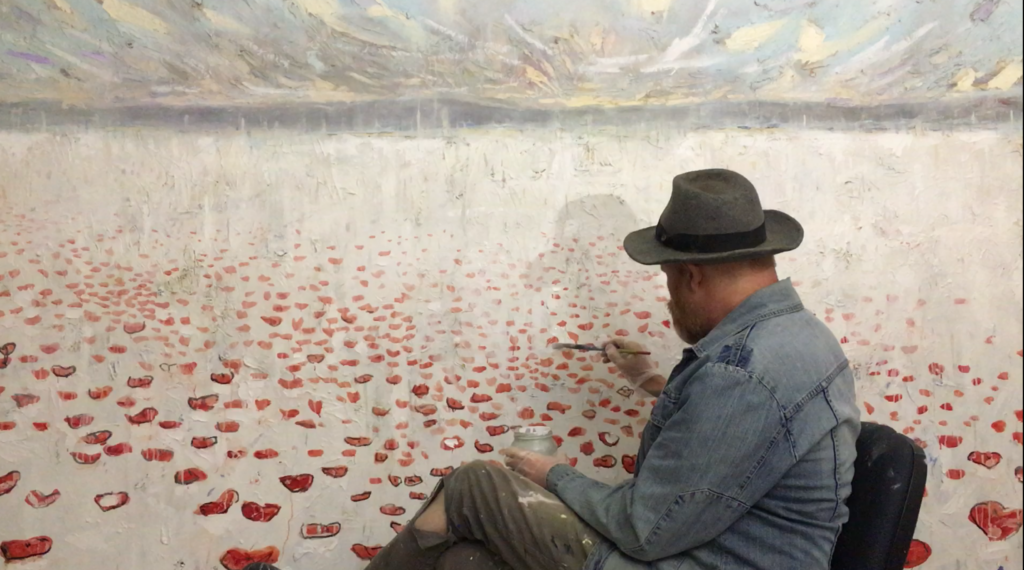
WEEK 9
So, last weeks paintings have dried. I’ve only managed to track paint throughout the house and wrecked furniture twice, and the cat only dragged titanium white through the clothes basket once. I had a good week. Besides, ten new canvases were delivered on Tuesday that’ll keep me busy.
Below are some pics of work in progress and ‘almost’ finished paintings that underwent umber washes to give them an antiquity. I like the umber wash effect because it takes the paintings away from the high key tourist-tea-towel aesthetics and into something else. This weeks paintings also looked at the eighth (from last week) and ninth day of story telling from the later chapters in TD. I’ve got some more videos to share and general monologues coming.
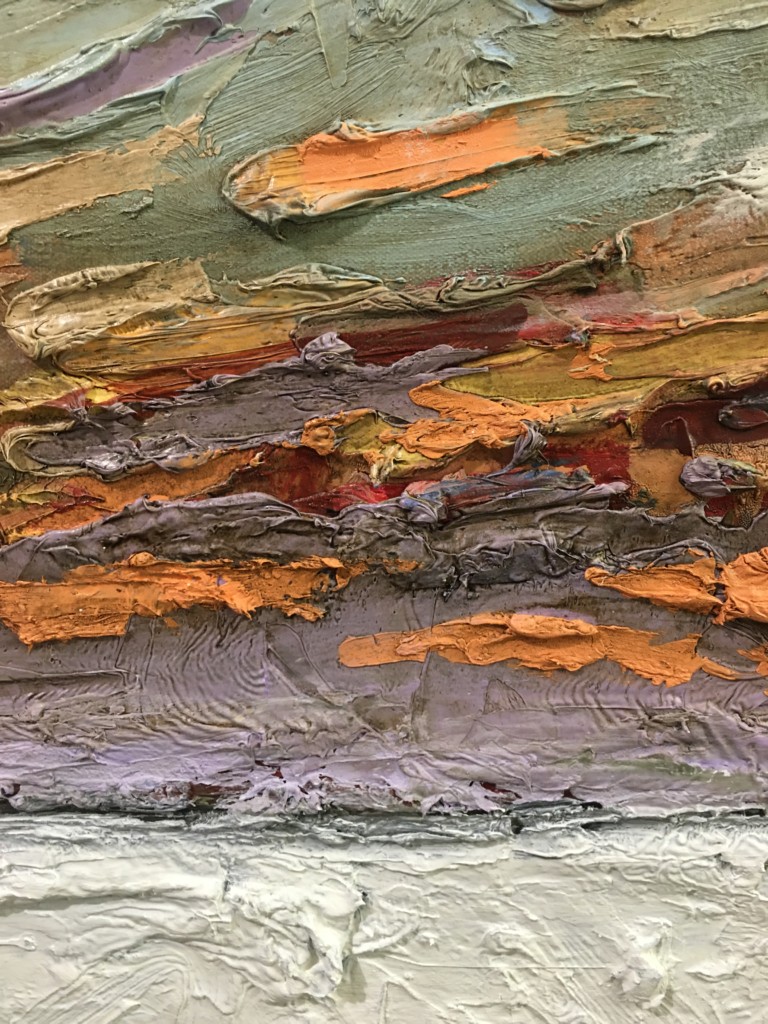
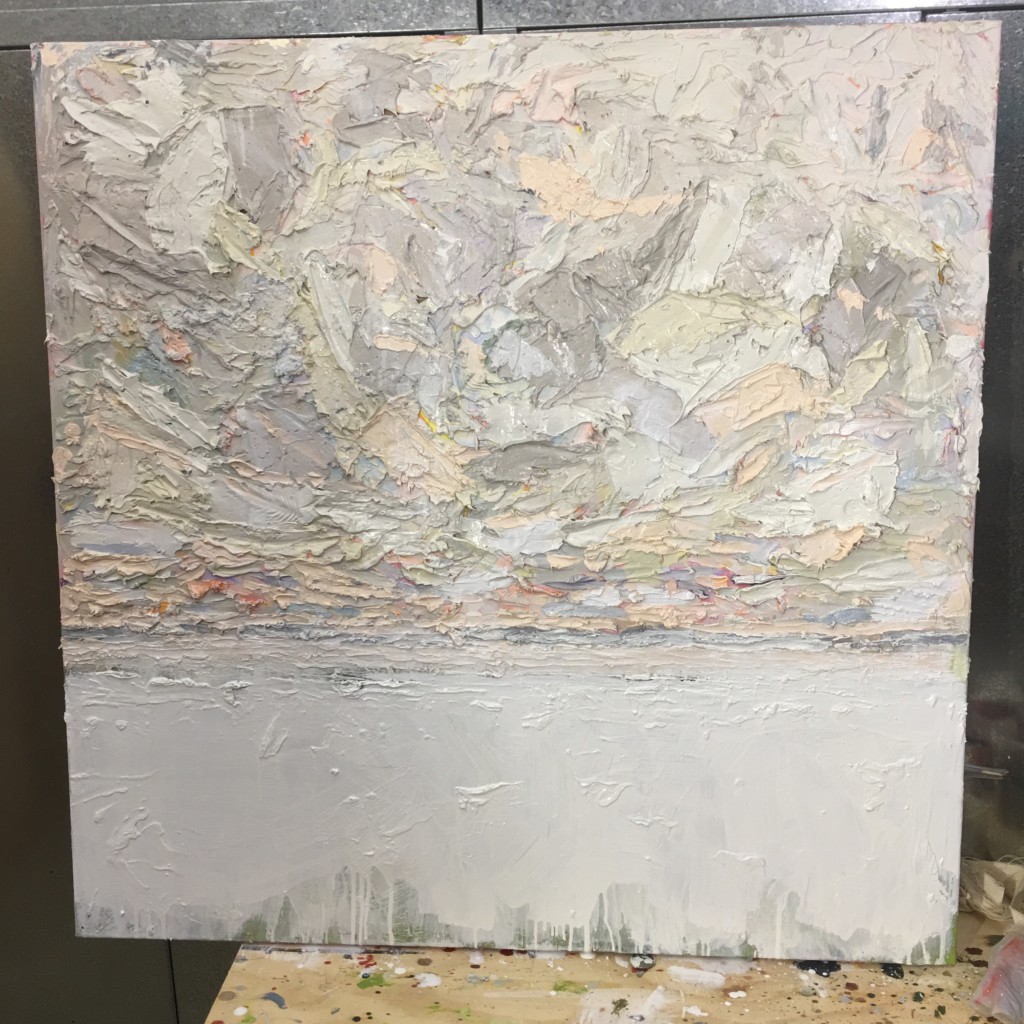
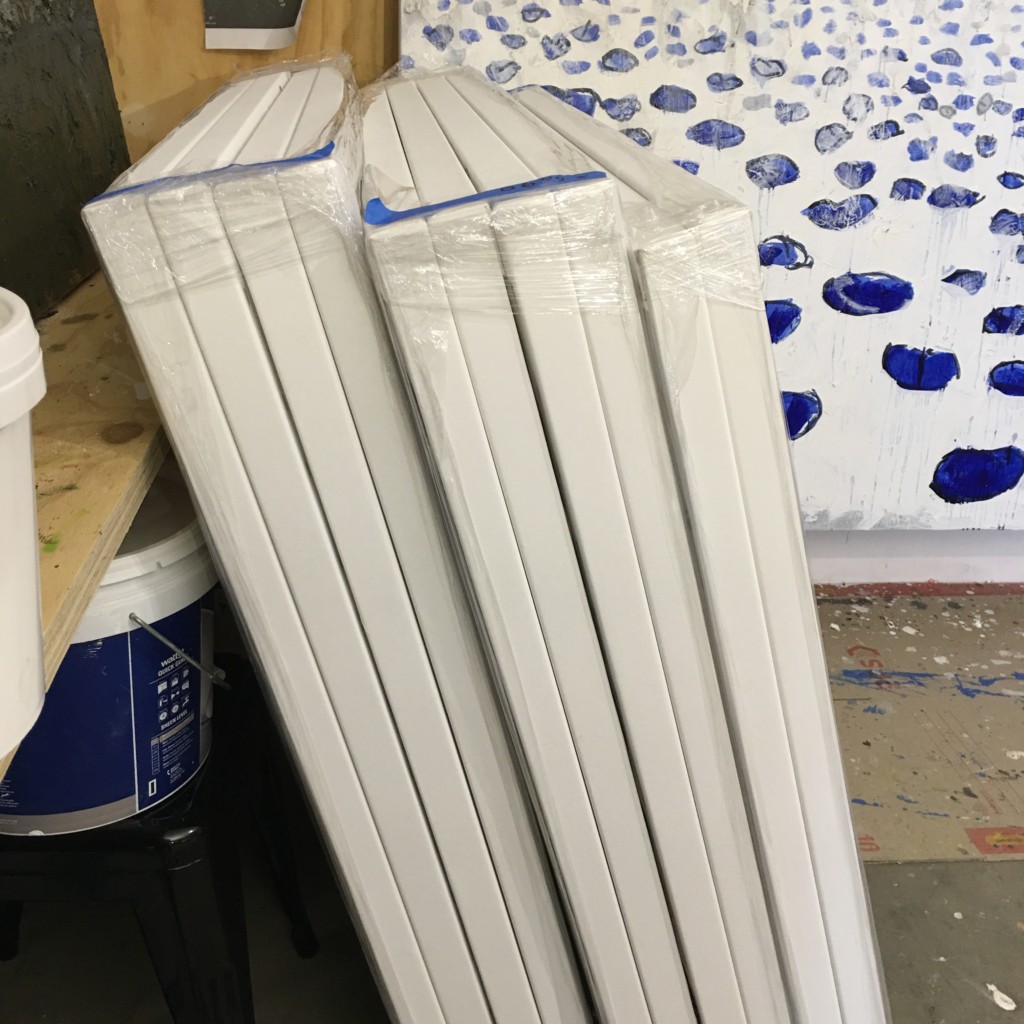
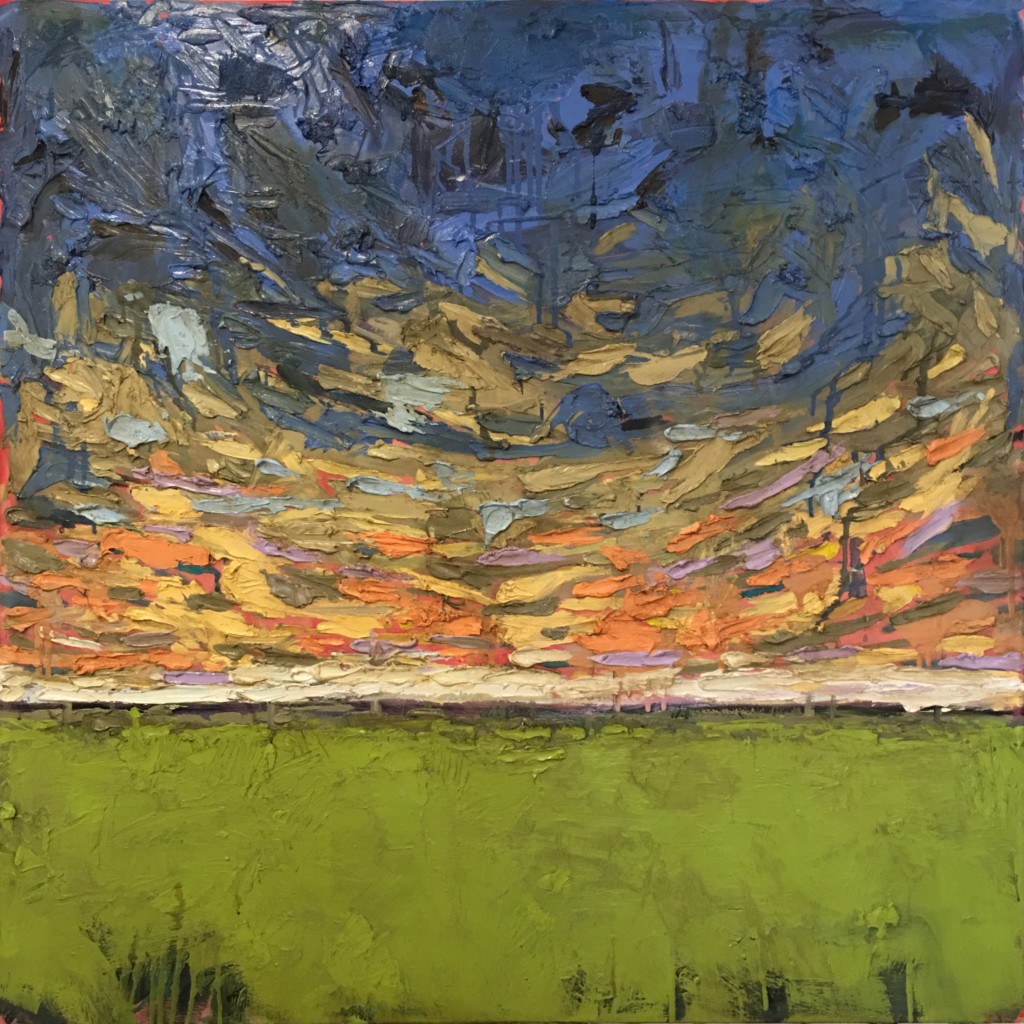
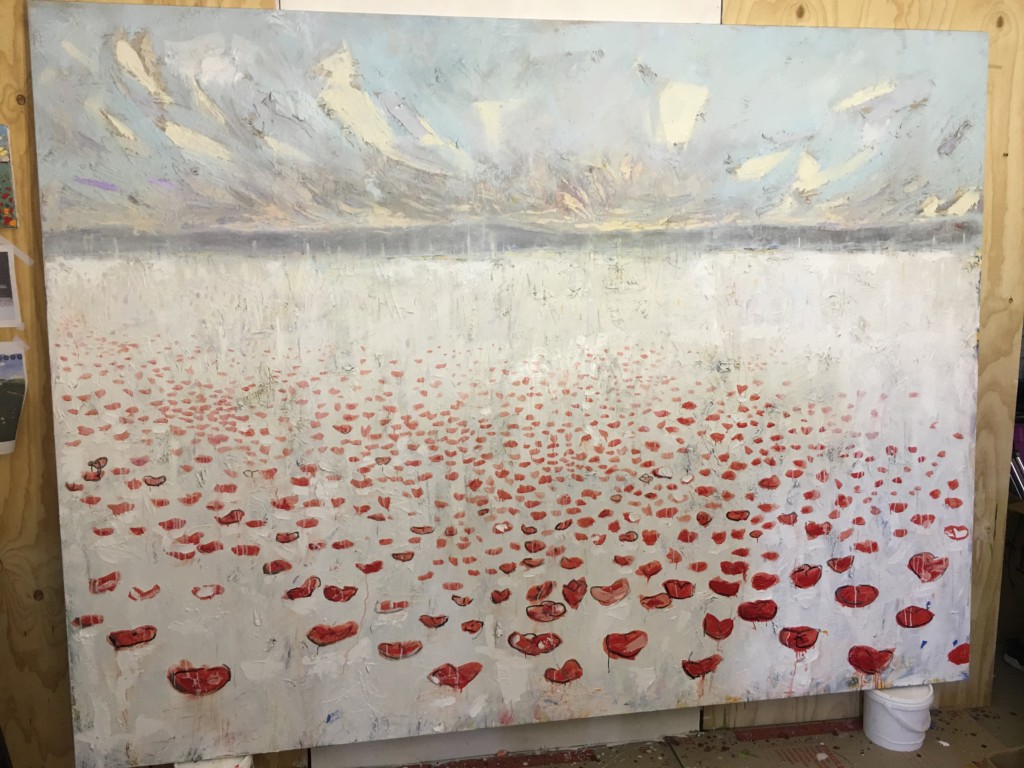
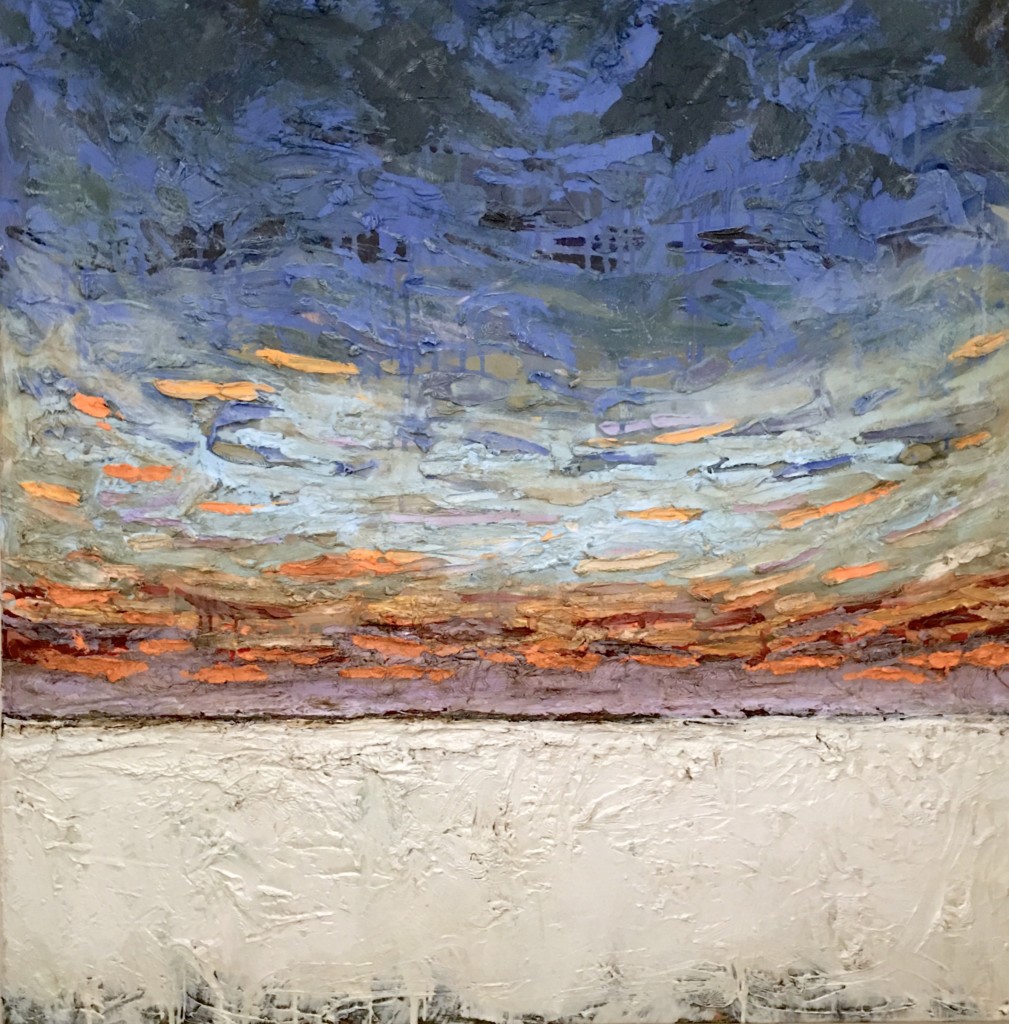
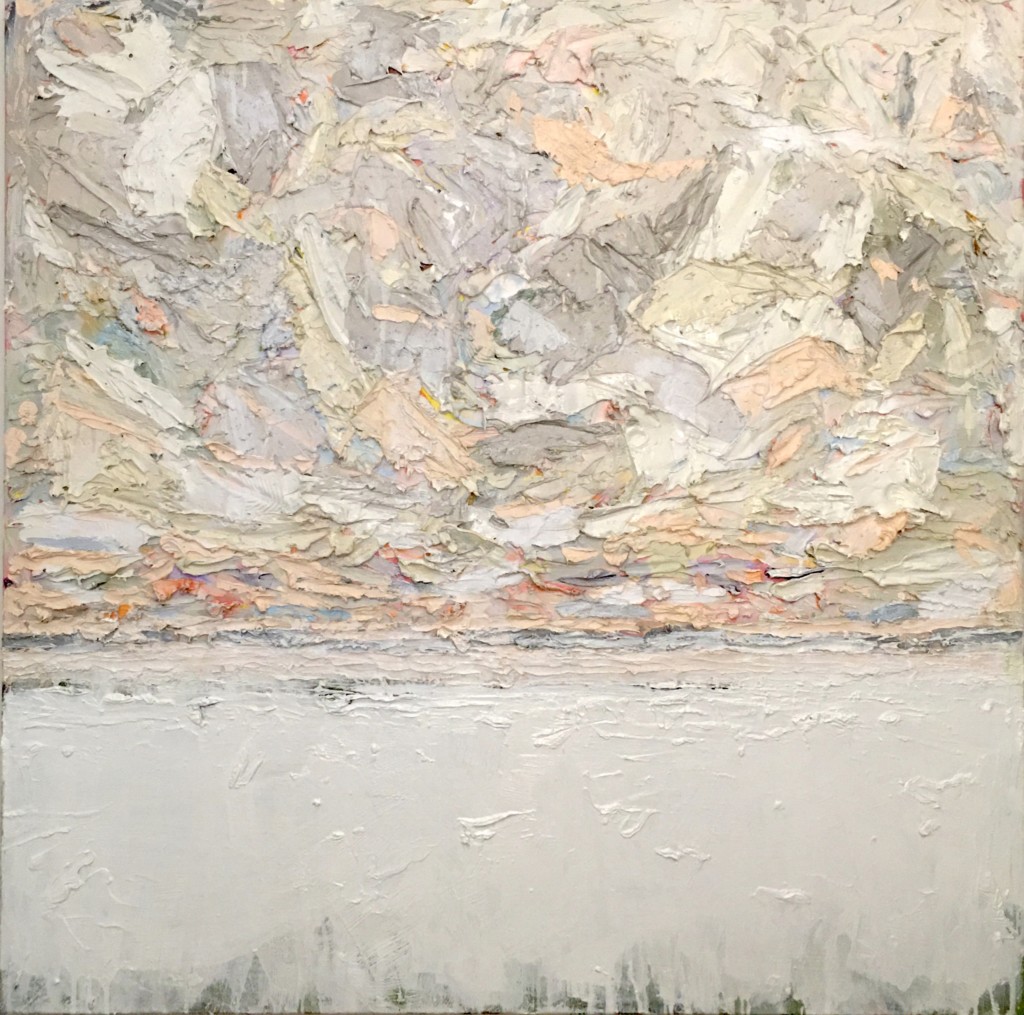
WEEK 10
I’m down to three paintings left. The eighth painting is drying and I have to add a bit more weathering to it and the ninth and tenth paintings are underway. I was particularly drawn to the ninth day of story telling as I got the sense that the story tellers in the book seemed ready to conclude their adventure if thats what you can call it. In the stories of that particular day, Filomena is the first narrator describing a more torrid tale of love and desire leading up to Panfilo’s later story which skirts around desire and scandal. These are quite different from a structural point of view of the earlier stories from the first two days as this probably says more about the characters in lockdown than it does about the conversations. Here are a few pics from this week in progress and a new video where I talk about the intention and logic used in my painting practice.
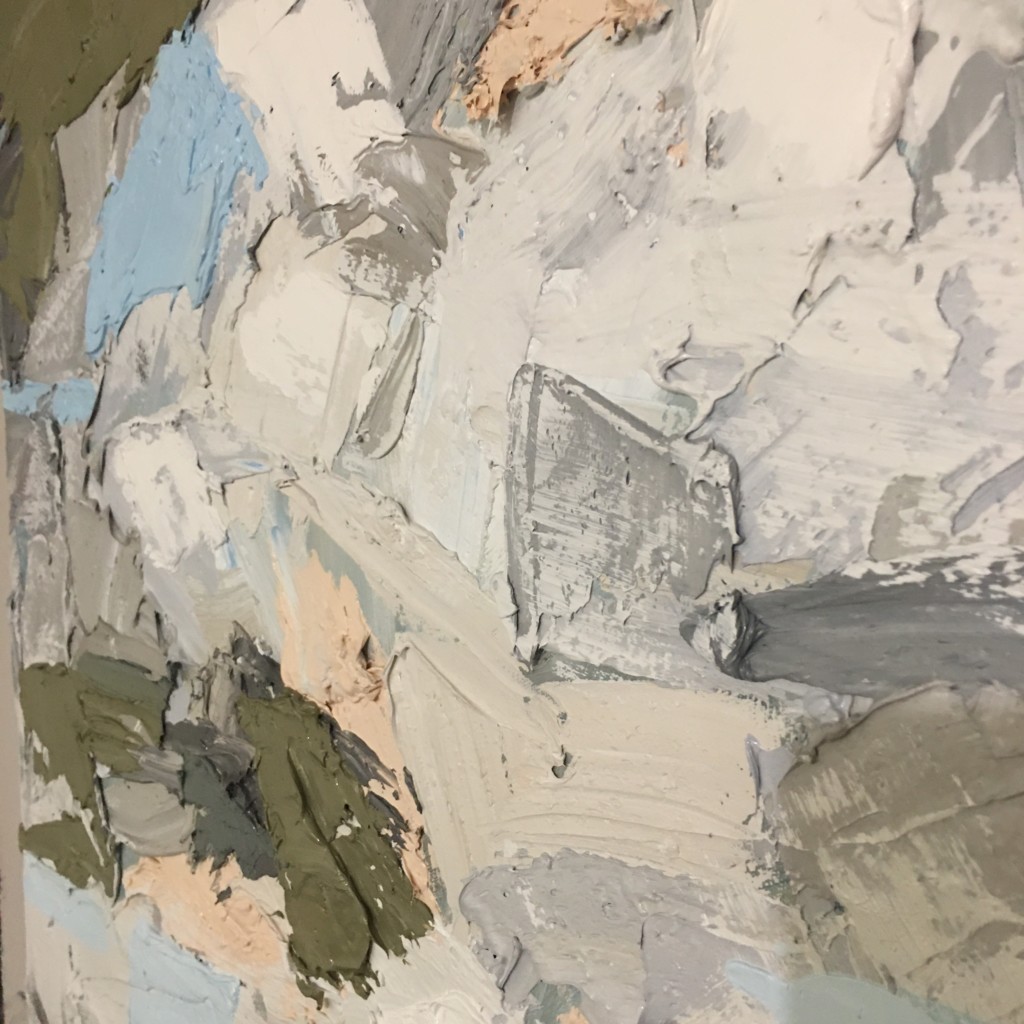
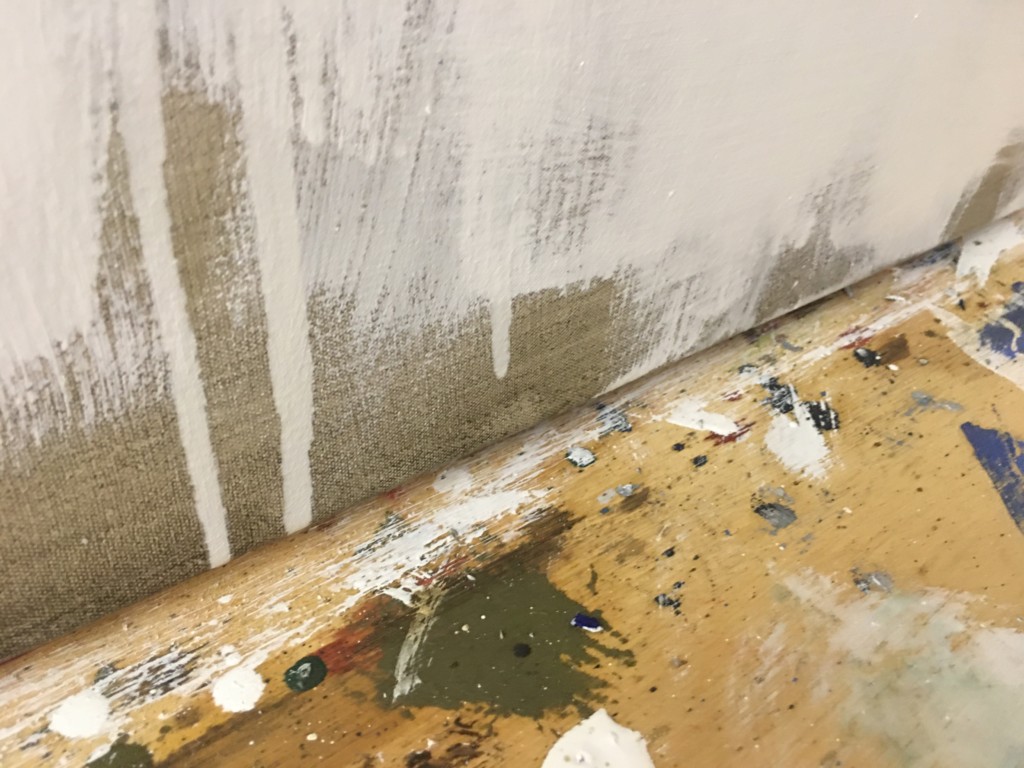
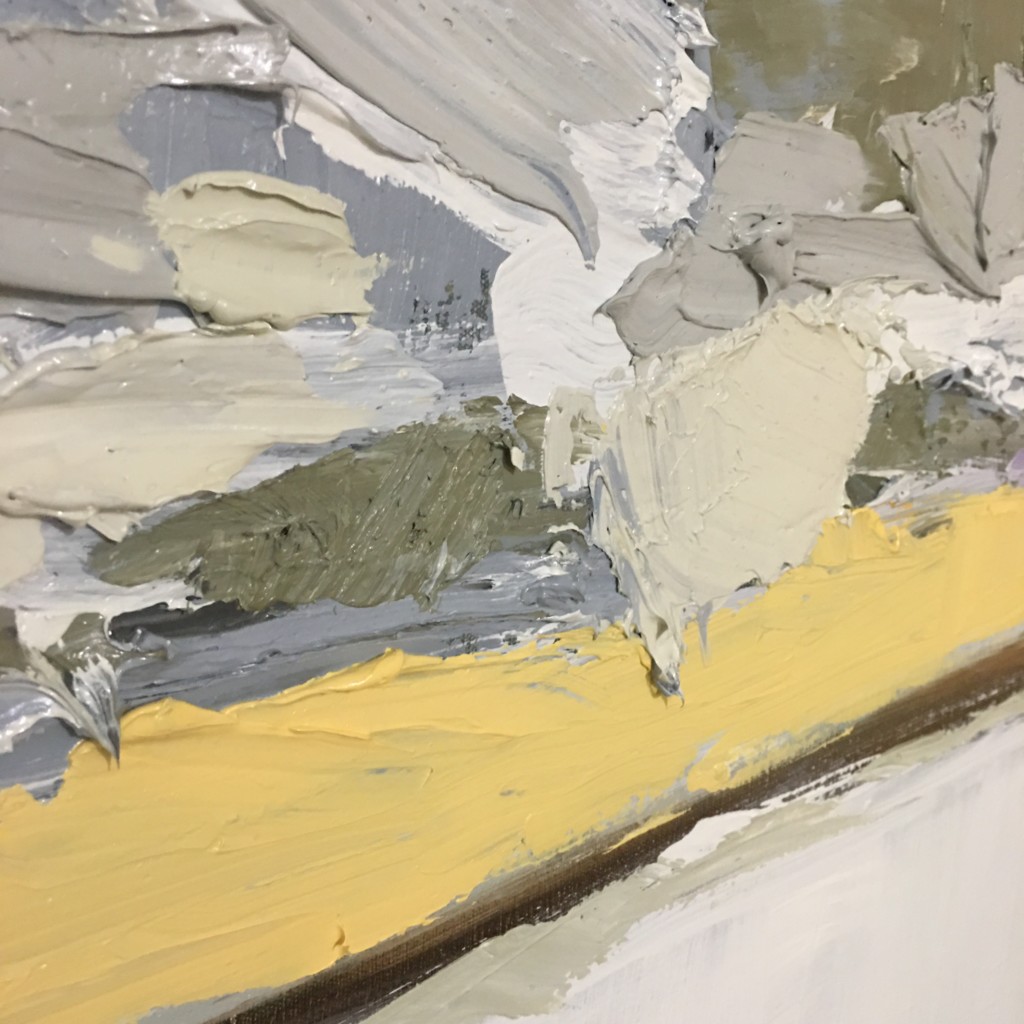
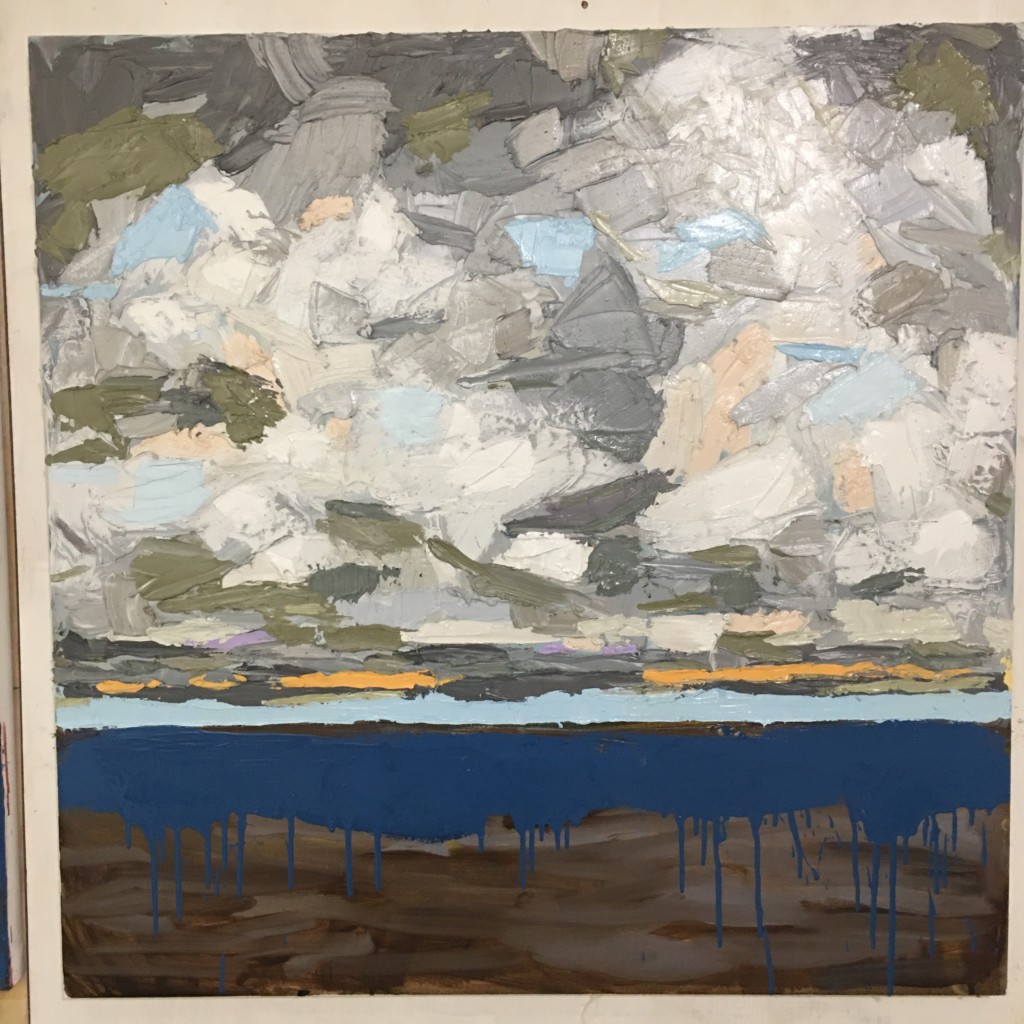
WEEK 11
The paintings of day’s 8 and 10 of the story telling are completed and its all down to waiting for Day 9 to dry so I can then attack it for the last of the washes and top coats. I decided to end the series on the return of the ten in question back over the river and into Florence which is why the last painting is blue. There were some good references in the last days to the change of the landscape described in the book and indeed I interpreted that as a changing in the character’s sense of place comparatively observed to the mood of the ten at the start of the first day of stories. I’m not sure why these paintings are taking longer to dry but perhaps its the change of weather not being as cold as it was ten weeks ago? I never was cut out to live or function in Australia. For me, if it’s over 15 degrees, for instance, I find it completely uncivilised. A good minus five degrees would suit me much better. Maybe I should just go live in a villa overlooking Florence during the winter months? If I could I would. Or maybe buy a house in Fremantle and turn the aircon up in winter to my favourable -5. I’d get the best of both worlds then because painting these works reminded me that for the very few times that I’ve been to Western Australia albeit Perth, the world seemed to make much more sense over there. And the people did too. Tasmania has the same effect on me and so does London – the grey skies, the bitter winters, and the darkness at 5pm, I would be in my vampiric element. Anyhow, back to the art… I’ve started the offset series of poppy paintings of the same smaller size while I’m waiting for paint to dry and there’s definitely carry over from the body of work I’ve made into the new works. I can see an exhibition coming together now and also a book, thats usually the key point that I’m nearing conclusion of a series as I’ve pushed it as far as I could whilst still leaving space for what it flows into. The uncertainty of this series pushed it along in the developmental stage as there was definitely no white knuckle driving. These paintings were driving me. That’s a first. I have to admit though, next week could be my last week and I do feel a sense of sadness coming over me in that this series is closing and so too is my residency. I hate goodbyes, I absolutely dread them and it’s one of the reasons why I was drawn to Boccaccio’s book. Maybe it’s a sense that the pandemic may be coming to a close sooner than later, this horrible beauty and the beautiful horror of the last two years, its sadness and loss, and its devastation and resolve has knocked everyone over the head in ways we never expected. I can’t quite put my finger on it but the engagement with FAC has been one of the most rewarding artistic projects I’ve done for the past twenty years because these paintings are as much about me letting go and being taken hostage by paint as it has been not having a plan except to start a journey where I didn’t know where I was going. That seemed like a good place to start.
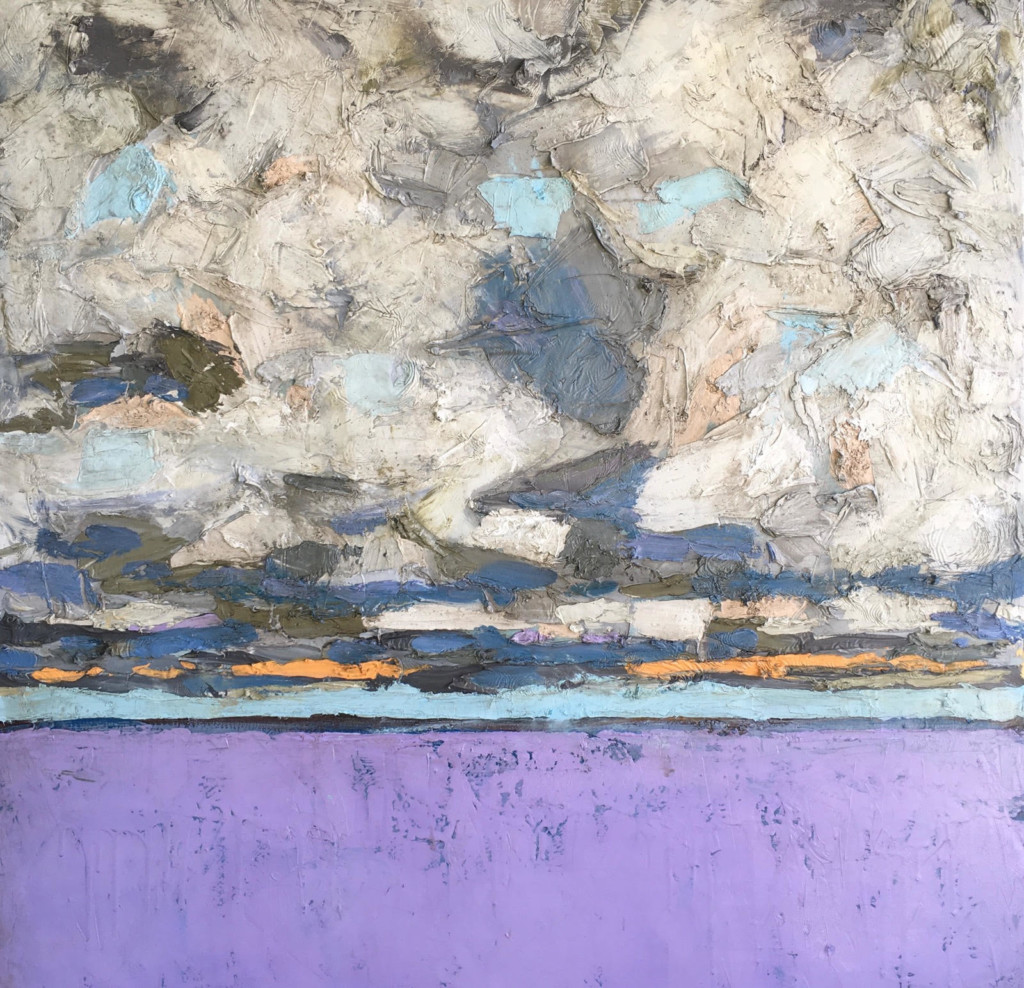

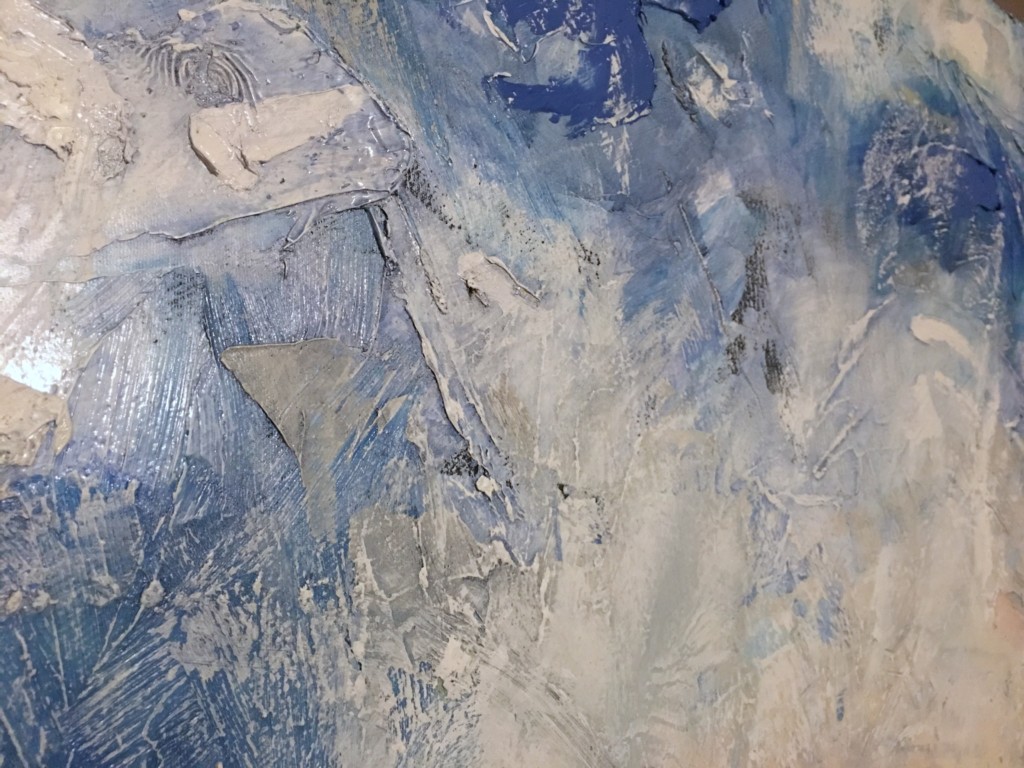
WEEK 12
So, the paint on my last painting is still tacky, I can’t finish it in time this week and I worked out why. If you leave Medium No.2 in the sun for any amount of time, it’s slows the drying process by a million years. Of course with 30 years of painting experience in a studio I obviously knew that didn’t I. Because I get impatient when paint doesn’t dry fast enough and how dare it not, here’s some pics of this weeks paintings I’ve been working on that are in the series that follows this residency all the while looked on by that pesky painting that just wont dry to lay on other layers. They’re from the COVID memorial poppy series and of course some nice pictures of my feet. Until next week I guess!
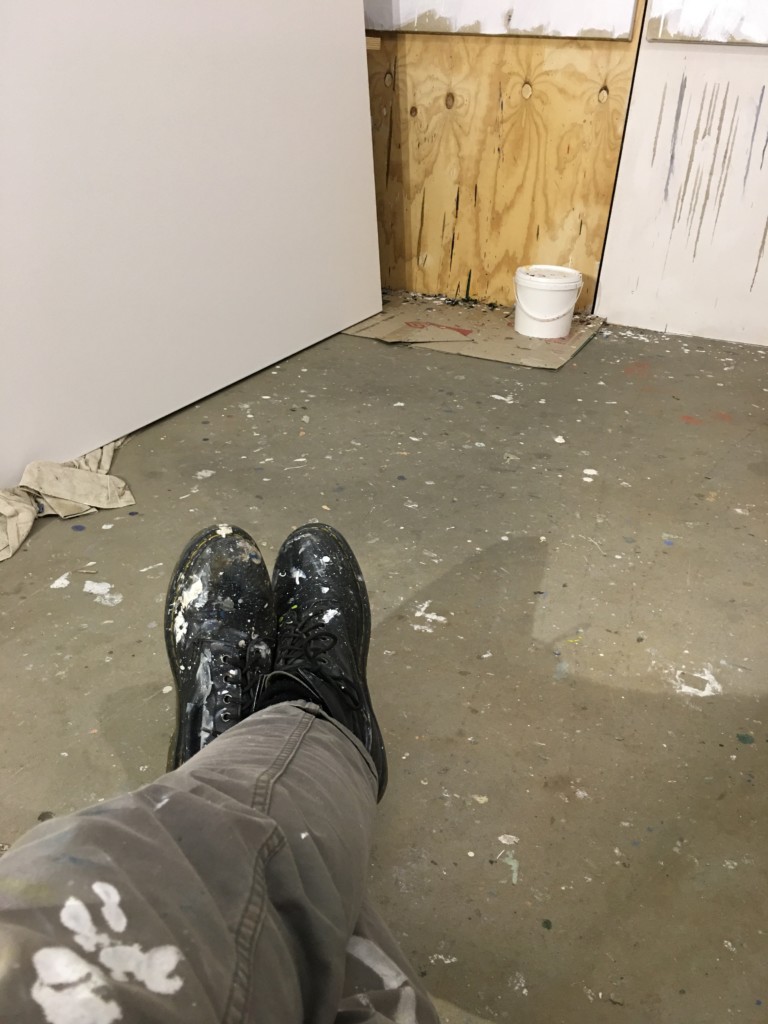
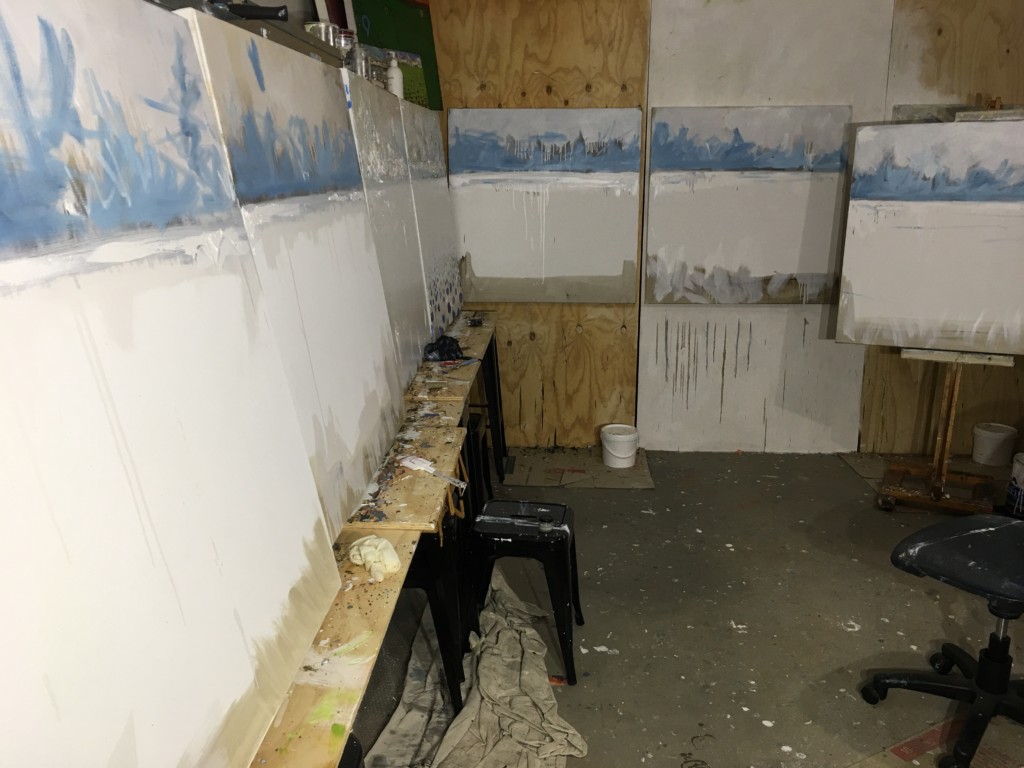
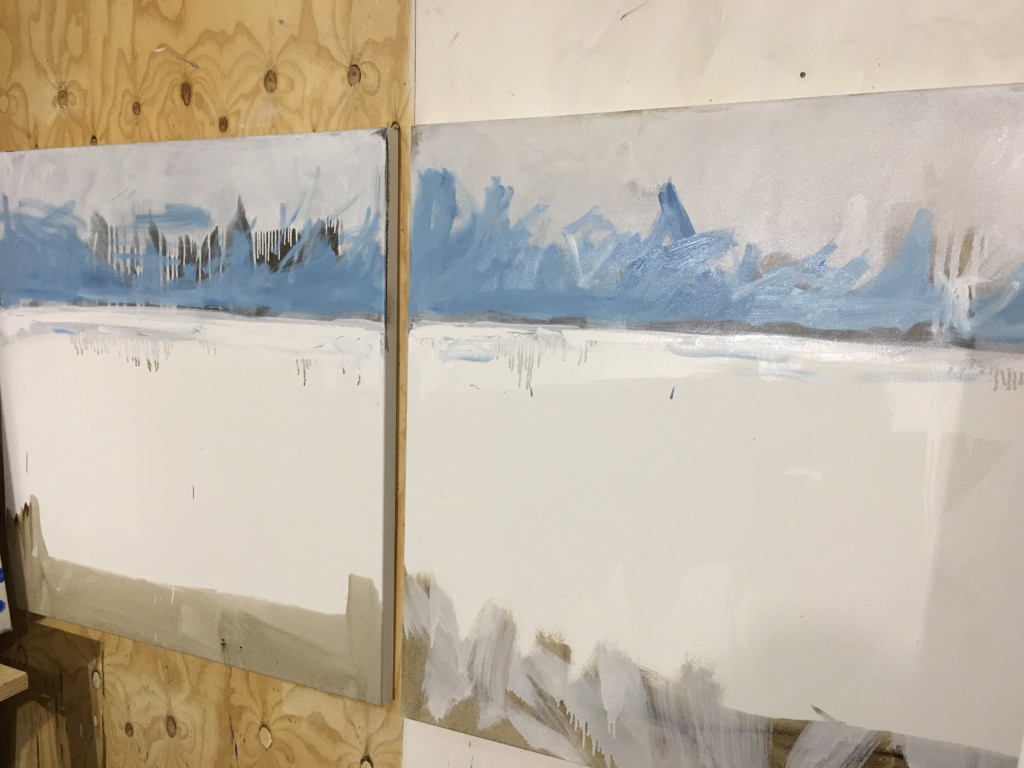

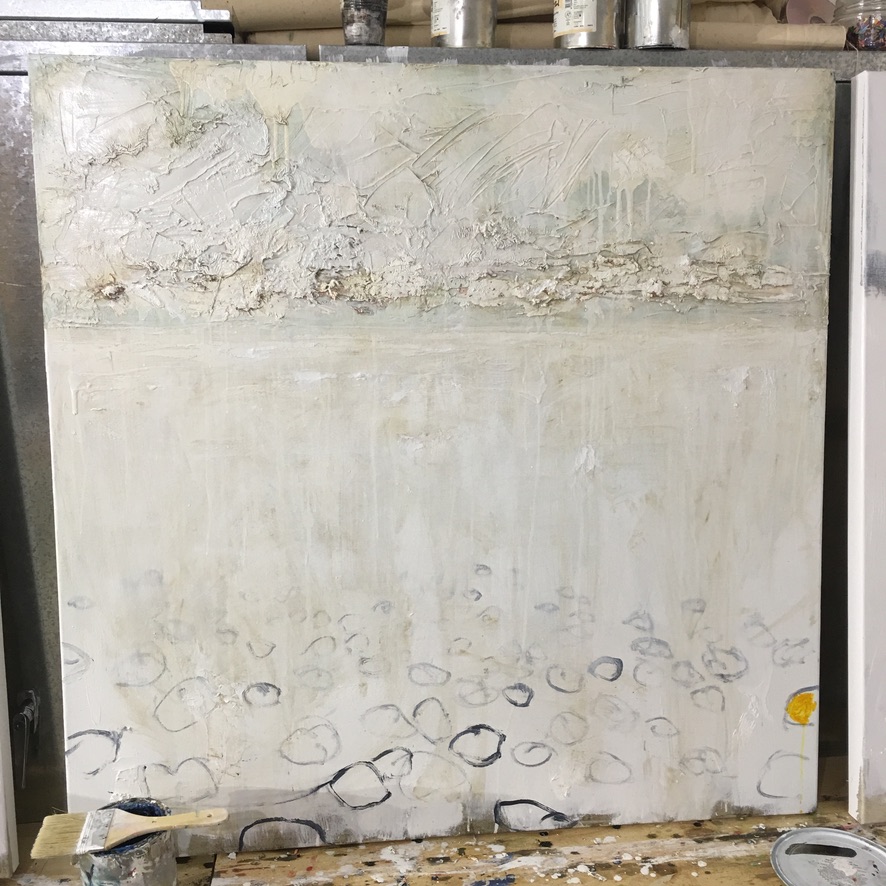
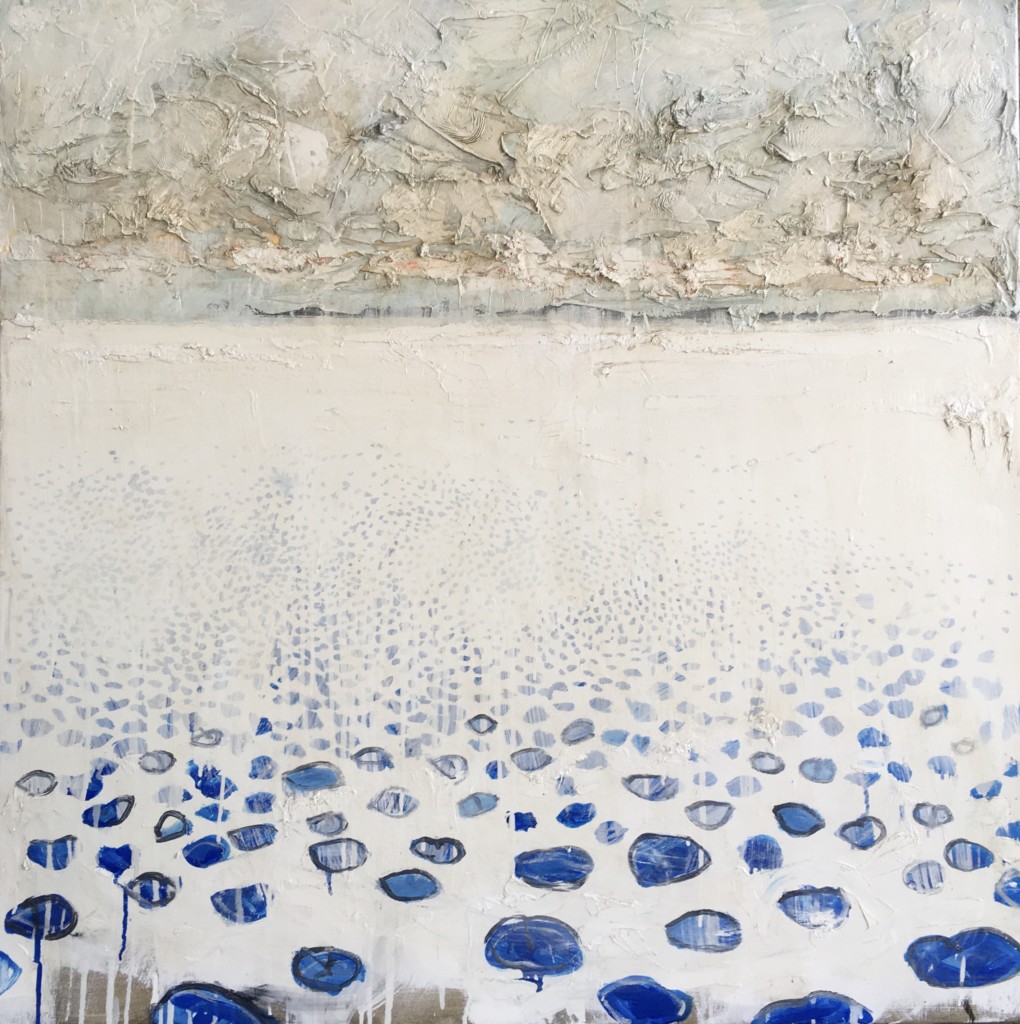
WEEK 13
I’ve just finished the last painting today and can now say that my residency is complete. If I was to reflect on the last thirteen weeks it’d be more or less a feeling of not driving the bus. It’s the first time that I’ve let go and let my paintings paint themselves where all I had to do is sit back and watch it progress. I’ve had to in effect teach myself how to paint again or at the very least remind myself what I used to use in the ’90s. That said, I’ve enjoyed this process to such an extent that it’s opened up an entirely new method for me to construct paintings both in terms of aesthetics and concepts. I can’t say that it’s been smooth sailing but the journey over the last three months has led to new discoveries, mistakes, and lessons learnt. Perhaps that’s the most important aspect of a residency even more so than what the outcomes of the residency produces. Apart from feeling happy that I’ve managed to complete the idea that I intended to pursue I am a little exhausted at the amount of effort I’ve gone to in creating these paintings. They weren’t easy thats for sure. Perhaps as life imitates art, today is also the last day of lockdown where I live in Victoria. Like the ten young people returning to Florence after their lockdown period ended at the conclusion of The Decameron, so too will I, out into the world again with this new series of work to show. I’m tired, sore, relieved that the last painting is finished but also sad to end my residency at FAC. It’s been a remarkable journey which I’m very grateful to have been able to undertake. To that end, to Bevan, Andrea, Ros, and Anna, my sincere thanks for letting this residency unfold in the way it has. Thats not to say though that this is the last time I’ll engage with the project. There’s a feature length documentary about the project coming out on Amazon Prime next July coinciding with a hard back book. You can follow me on Instagram or on my website (www.shaunwilsonresearch.net) to check for updates and announcements. Lastly, here’s the ten paintings in all their glory, hope you like them. Thats it for me now, wishing you all the best, cheers and stay safe Shaun.
